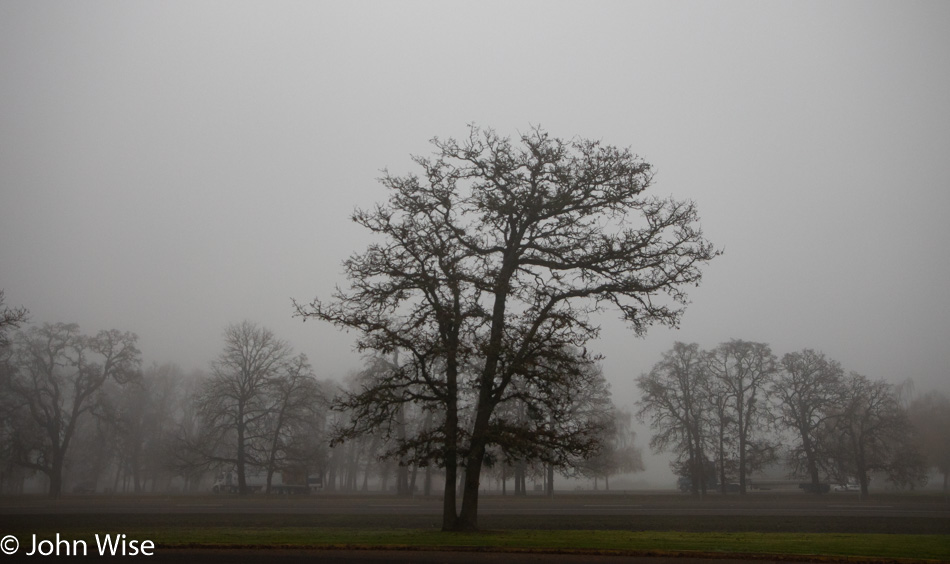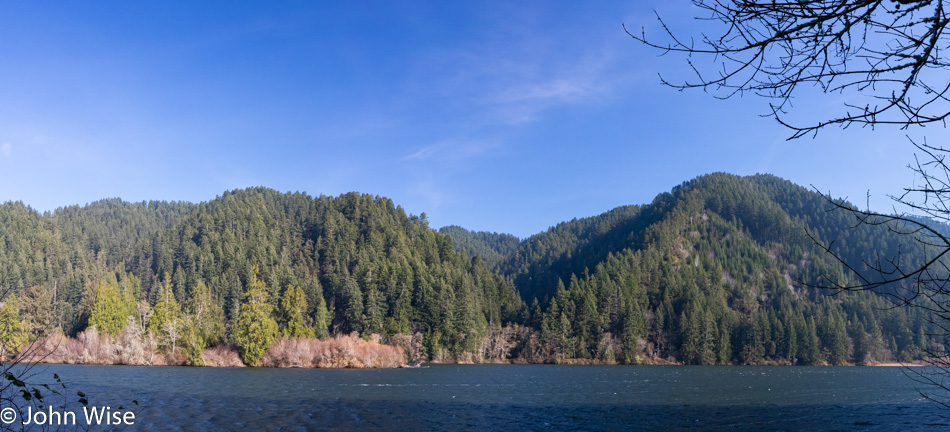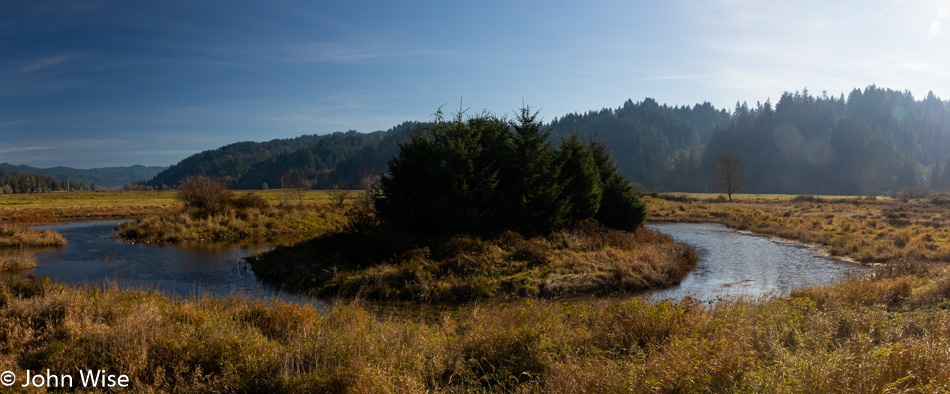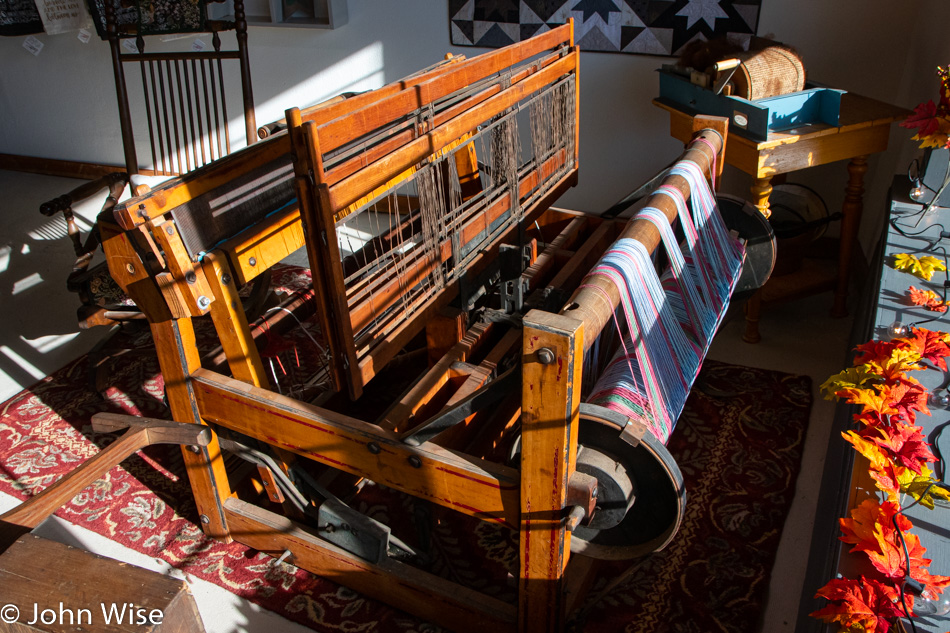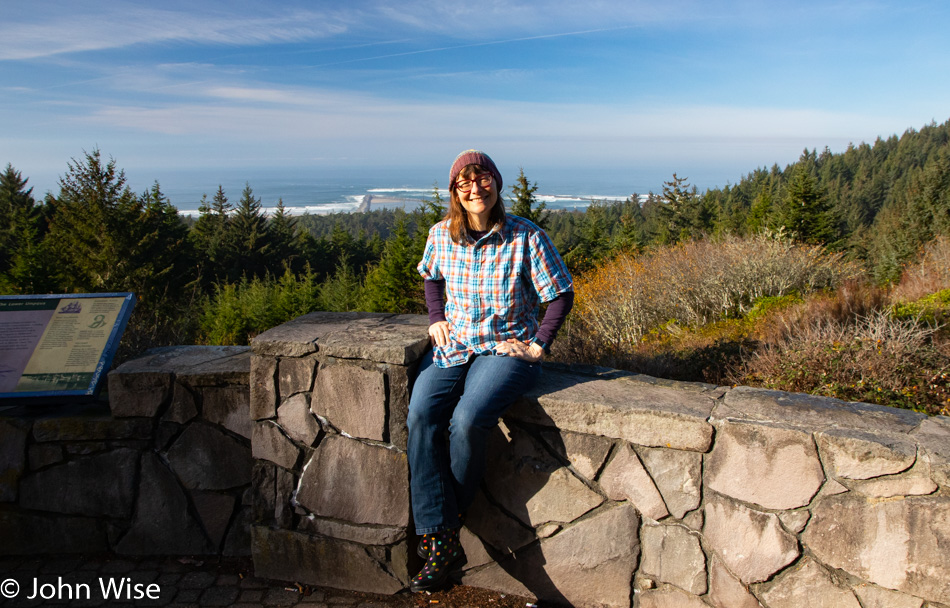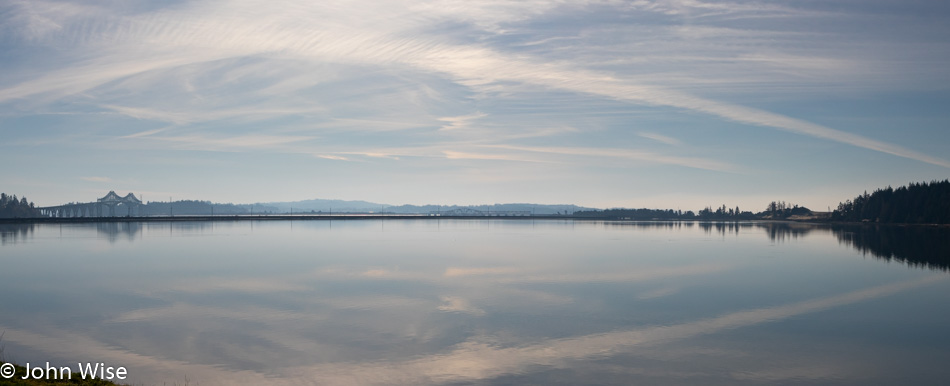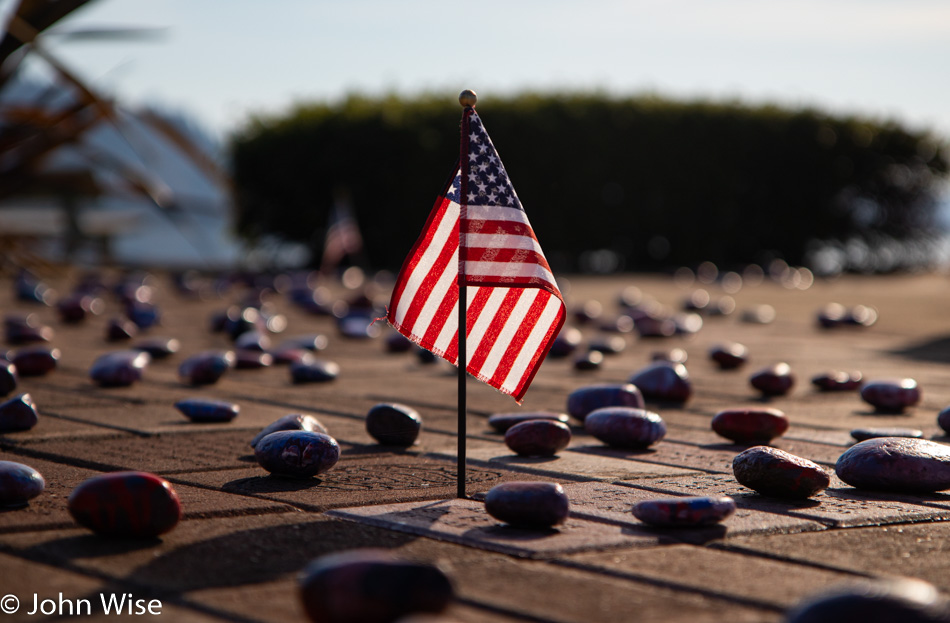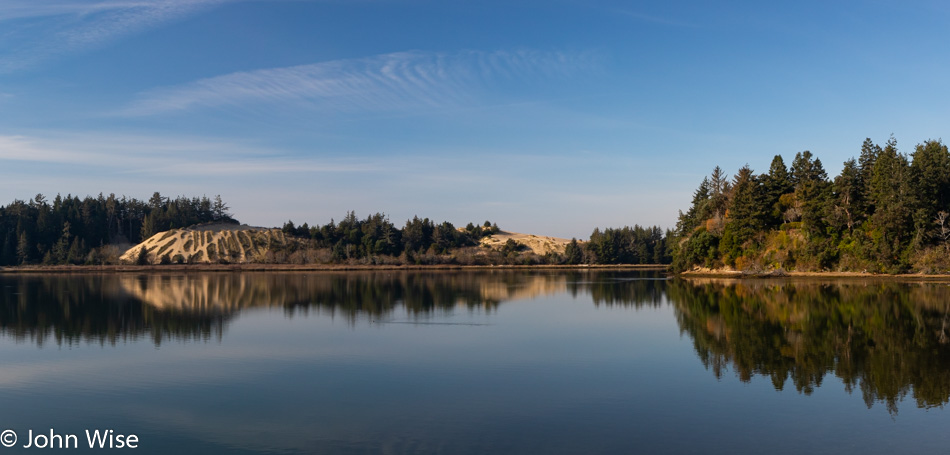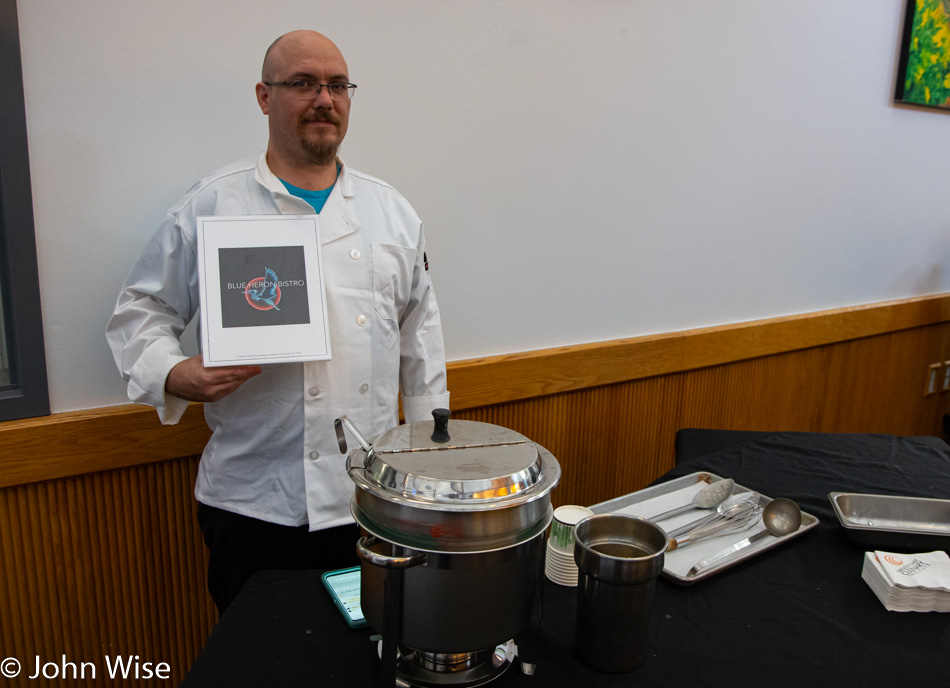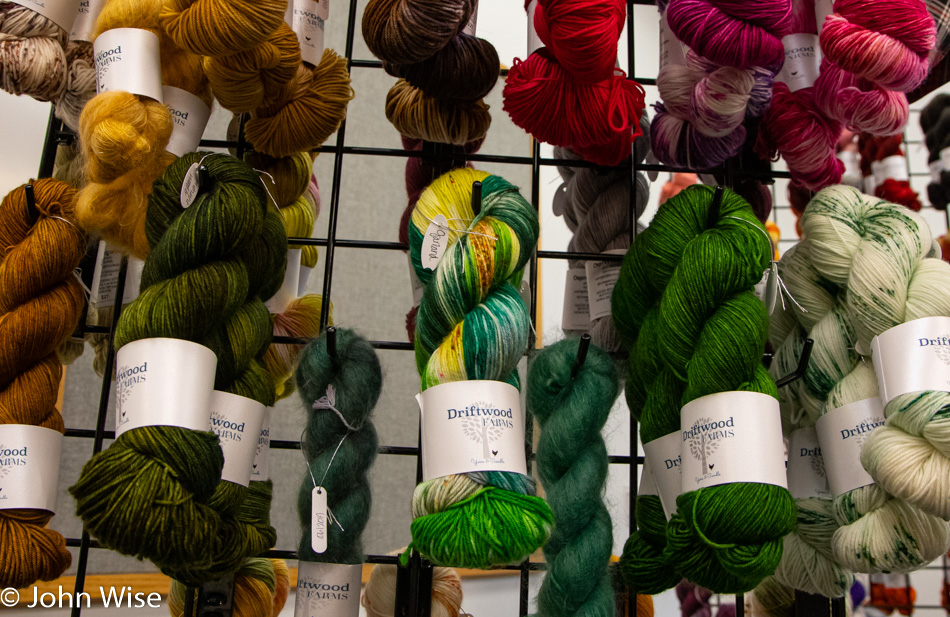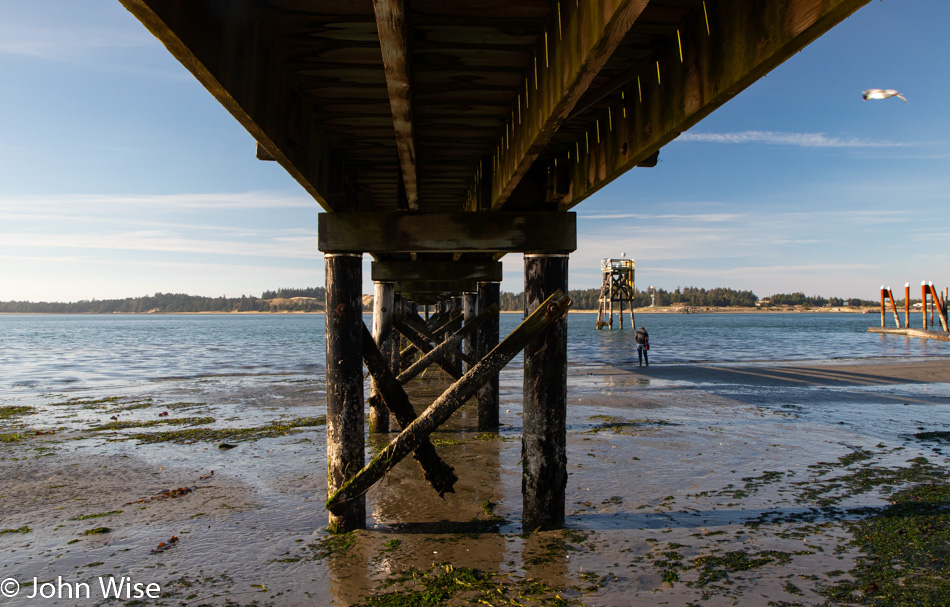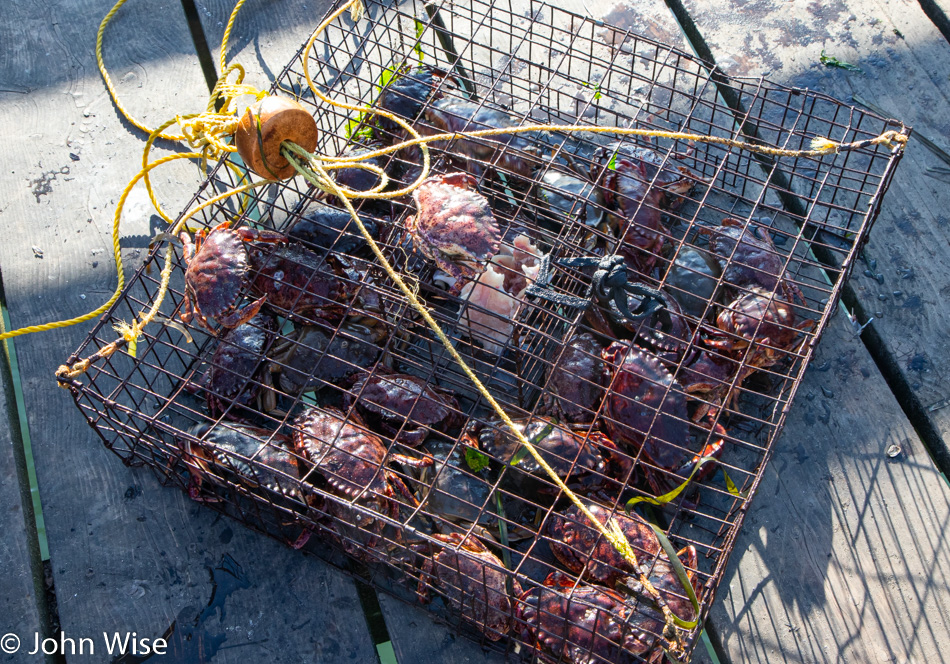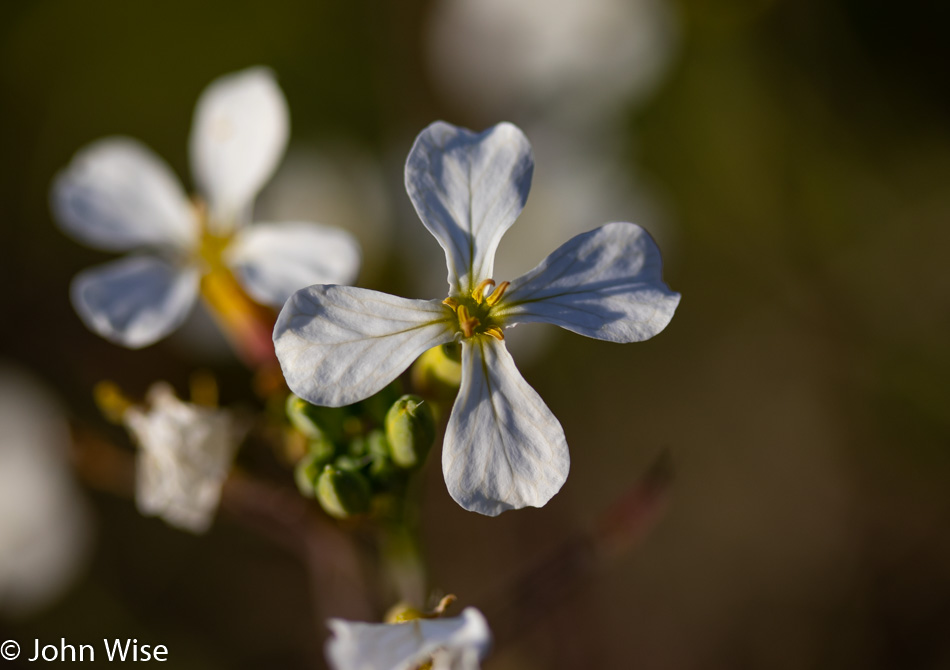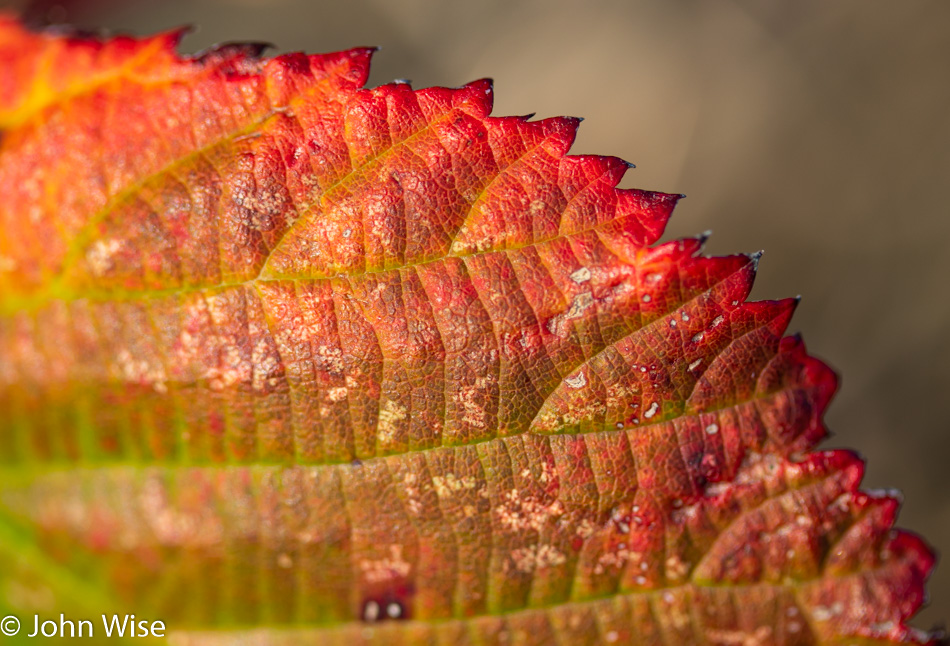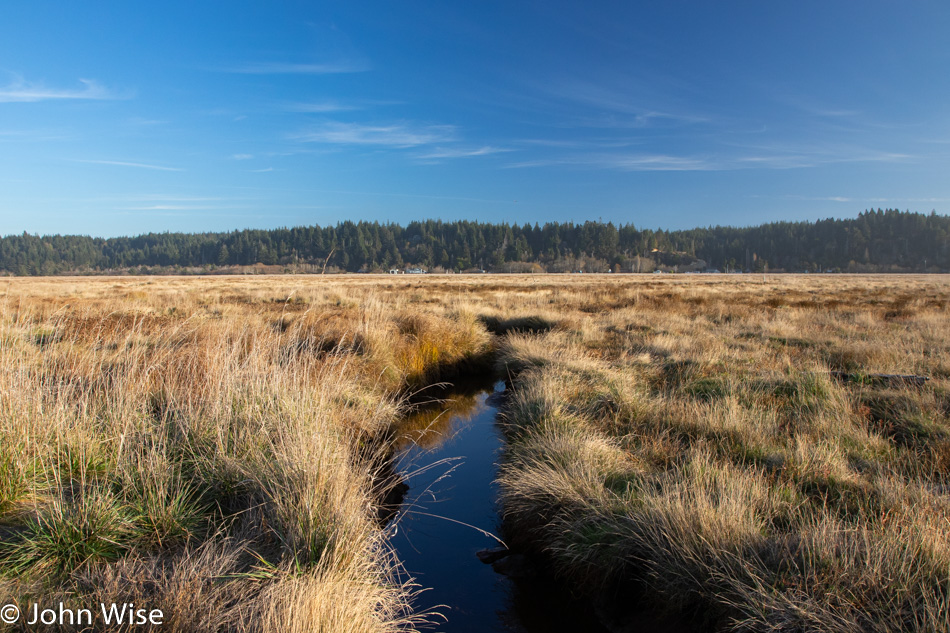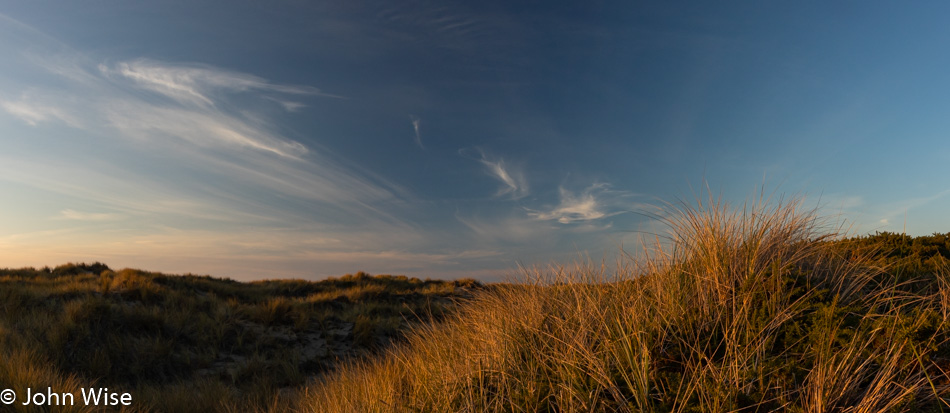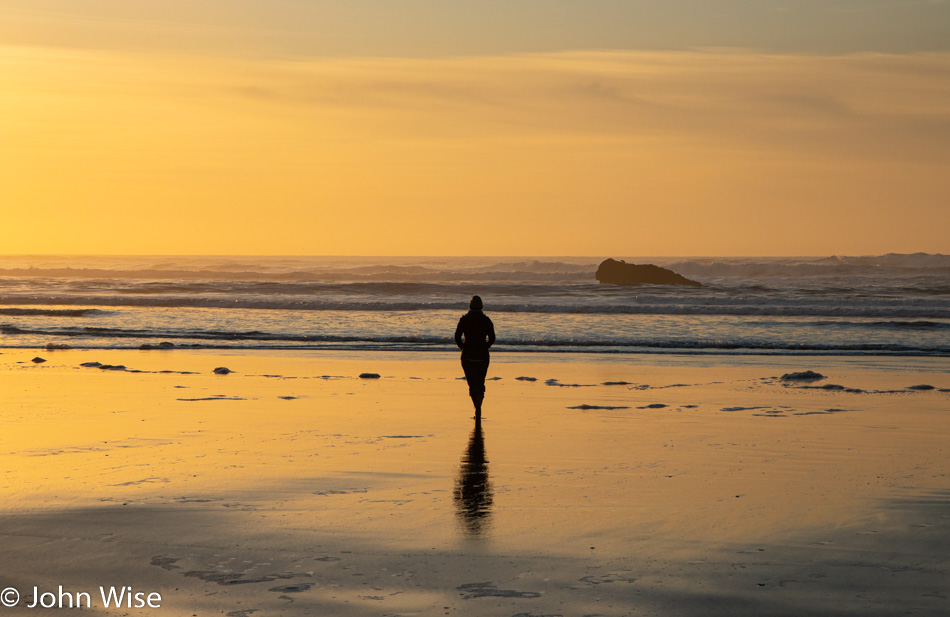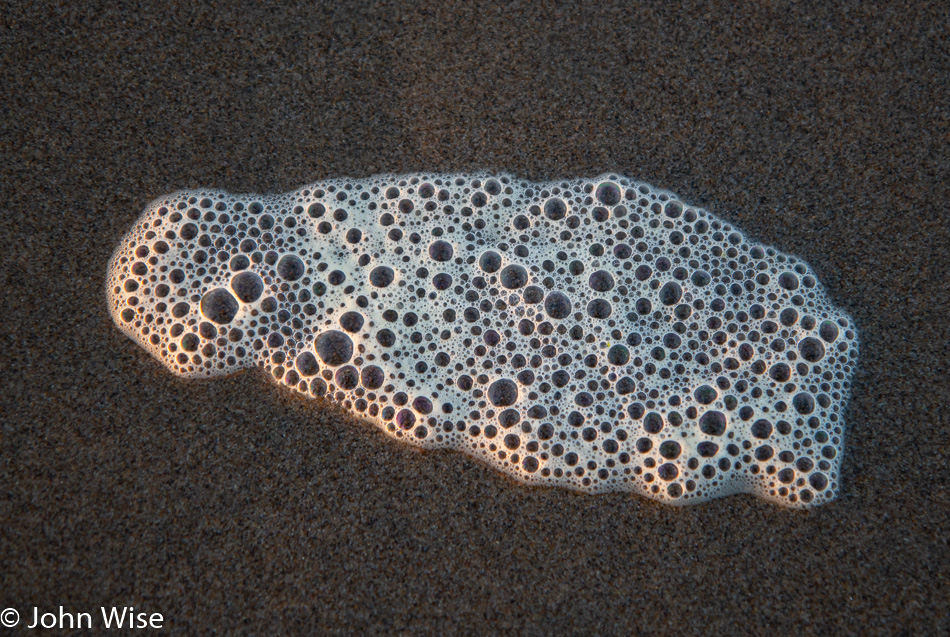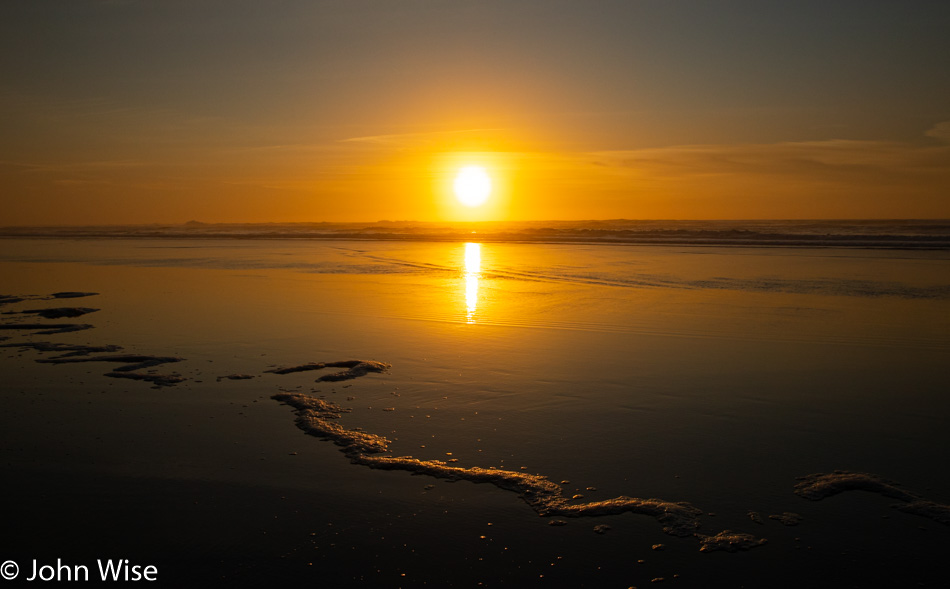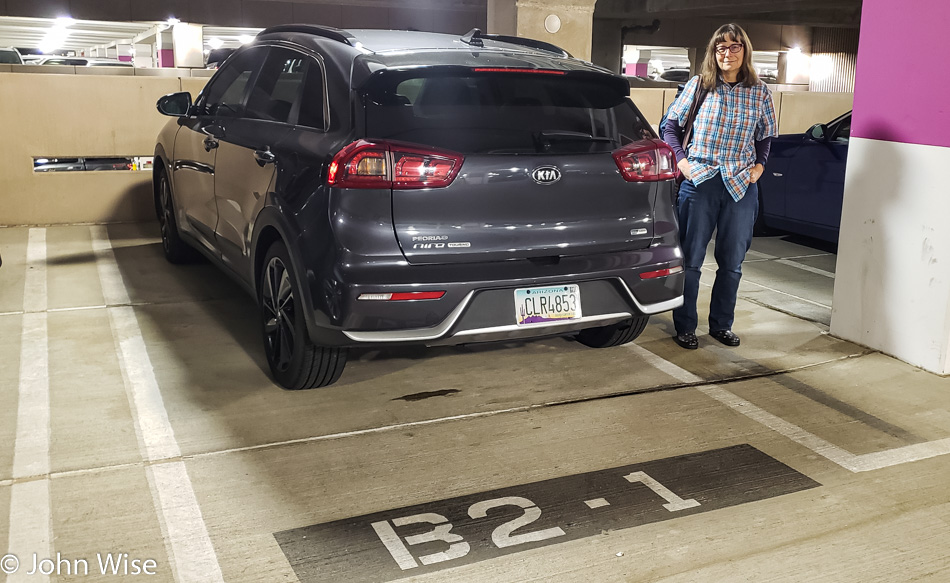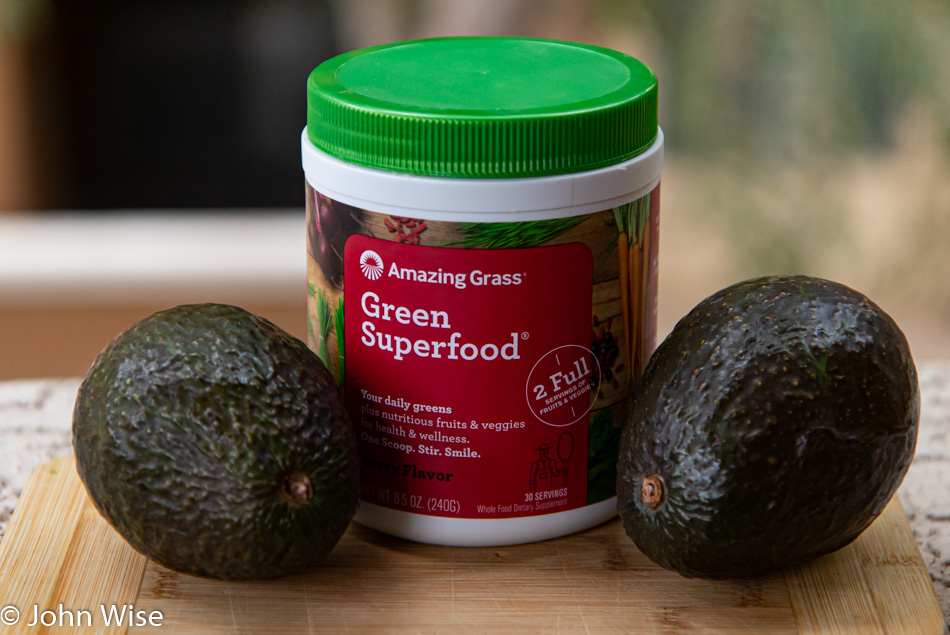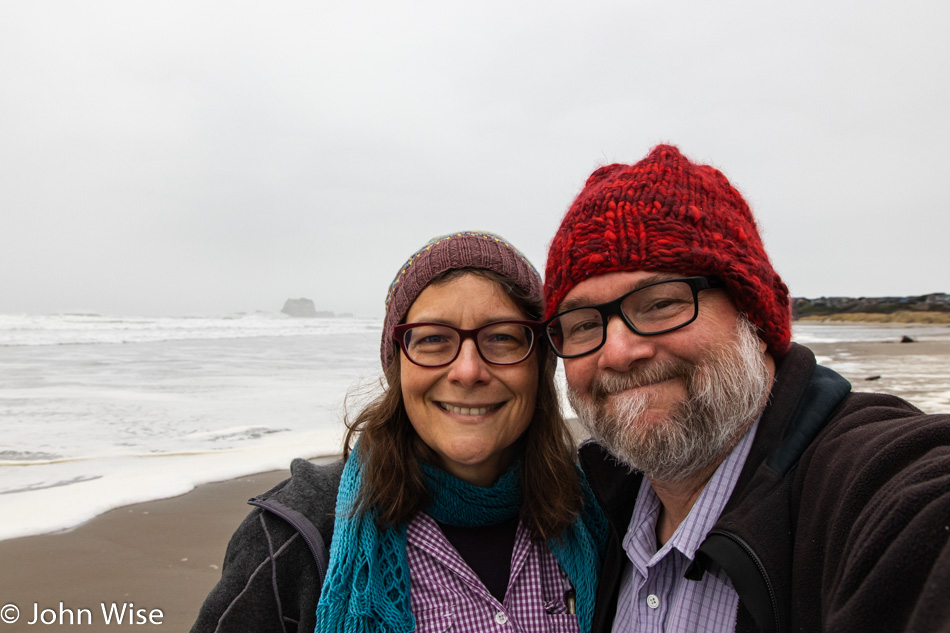
When starting the day on an Oregon beach, we don’t need the sun to make our faces shine. These smiles are produced by location, love, and the thrill of being able to wear warm clothes that rarely come out of storage in Arizona. This is south of Face Rock in Bandon, the same stretch of beach we were on yesterday during the sunset.
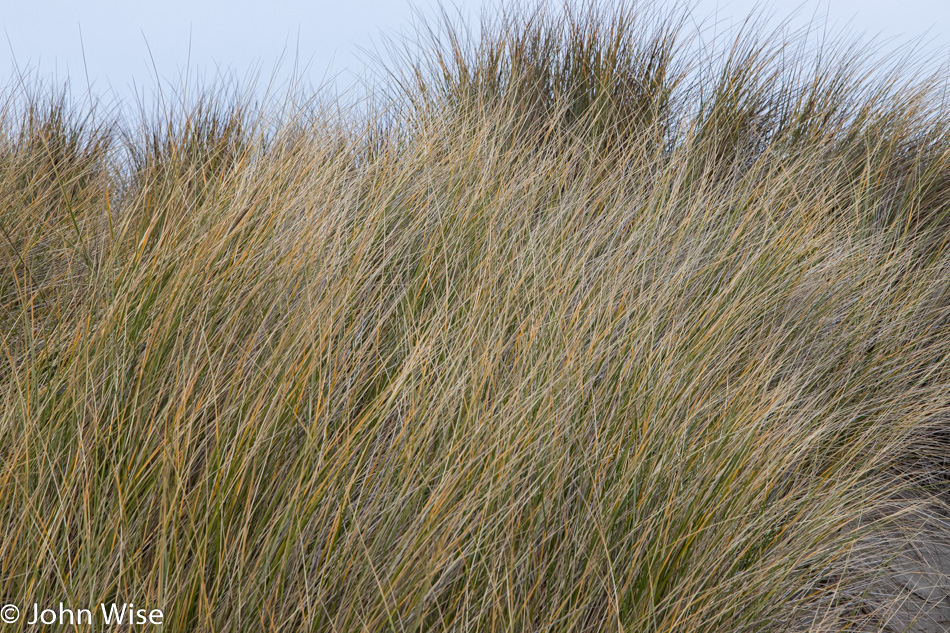
This is European Beachgrass, an invasive species found here on the Oregon Coast. We only recently learned of its negative effects on the coastline and how it changes the habitat in some radical ways. Still, I find it beautiful.
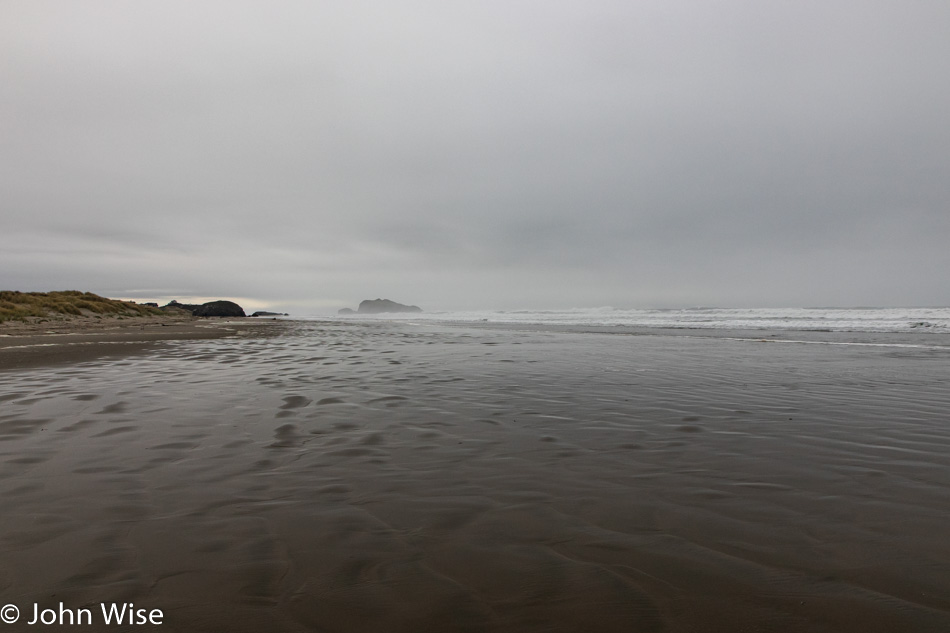
With a good long walk down the beach, we feel better about heading out for breakfast. A few other people with dogs and a young couple with an enthusiastic toddler were the only others out here this morning. For decades, Caroline and I have seen the sad reality that given the option of waking late, staying cozy next to a TV, and minimizing the effort of getting out, people opt for just that. While this lazy behavior has offered us quiet walks on beaches from the North Sea to Hawaii, I still can’t help but lament how uninspired the general population feels to me, with empty beaches perfectly exemplifying our state of woeful affairs.
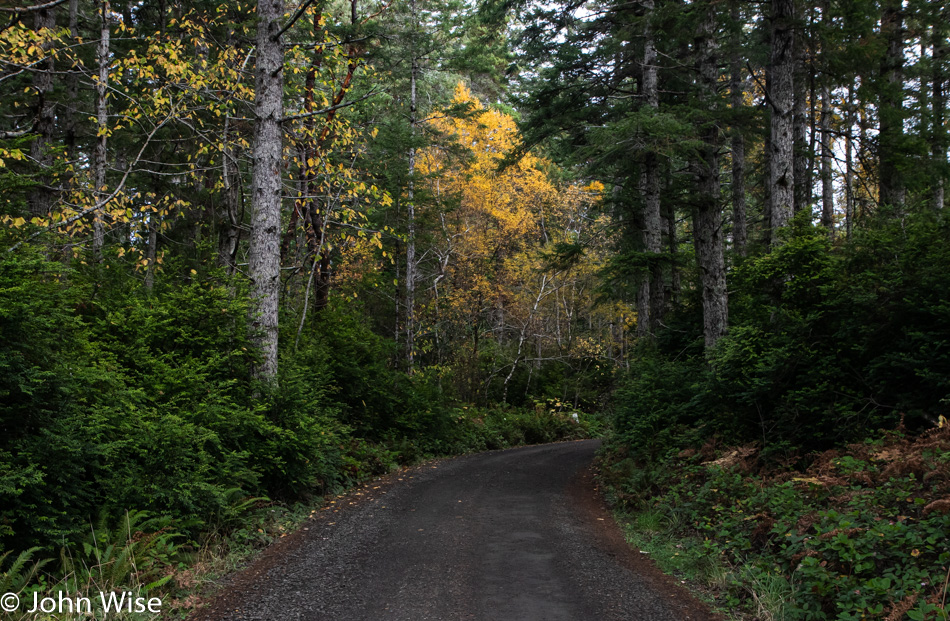
Stewart Lane seemed like a nice shortcut through the woods, but wouldn’t you know it that the not-so-trusty GPS maps that show the gravel road connecting to another backroad we’d like to take no longer goes through. So, was Stewart Lane a waste of time? Nope, we quite enjoy these little forays into the abyss of having gone nowhere.
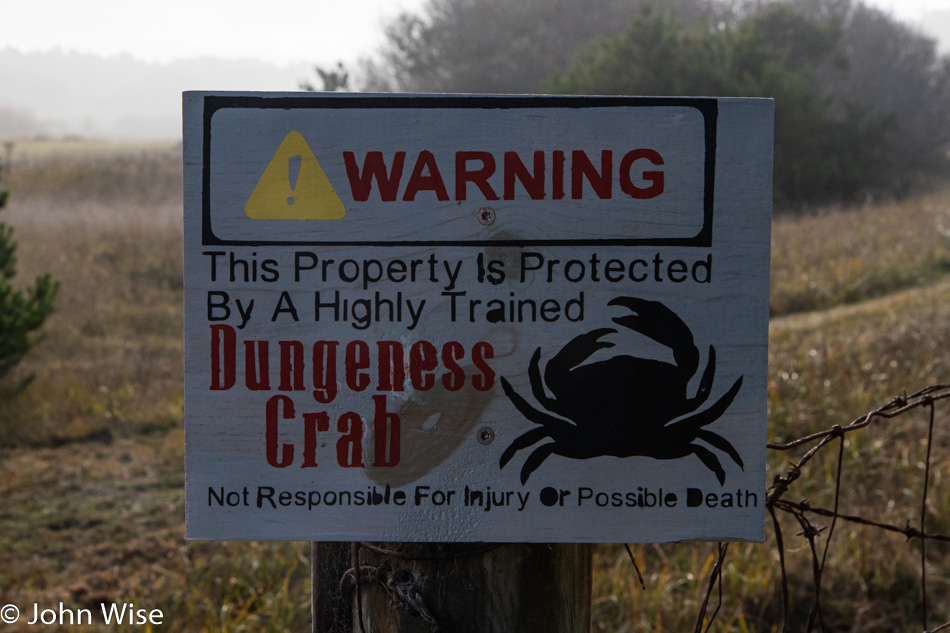
That backroad we were just on that took us nowhere was supposed to connect to Lower Four Mile Lane, which looked like it might let us get to a section of the sea we’d never visited. By the end of the lane, we turned around, having failed to find access. Just as we were giving up, a small sign (not this one shown above) caught my eye that directed us to the Four Mile Creek Trail. Skirting the edge of private property (see above sign), we took a nice short walk towards the Pacific.
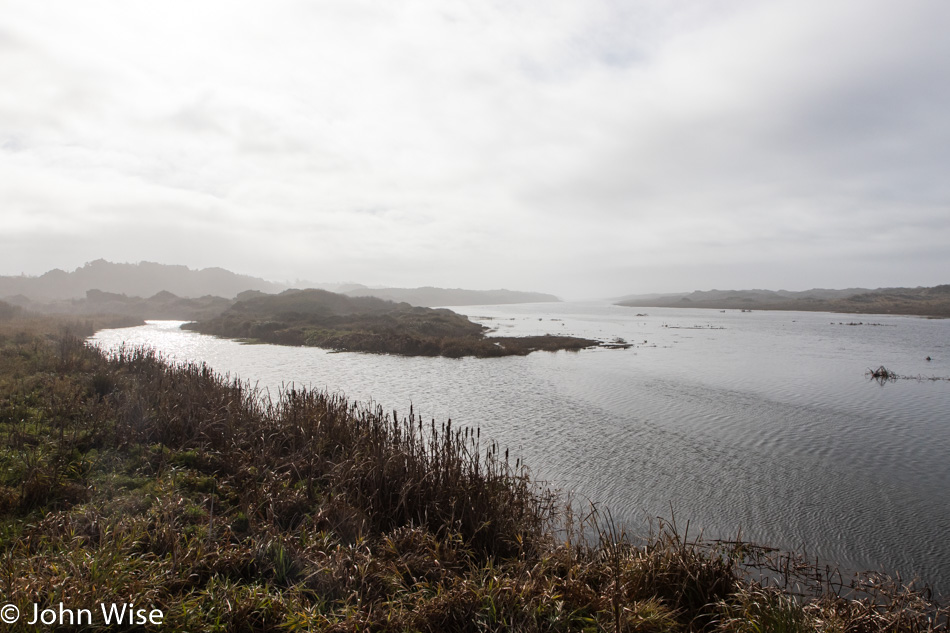
Four Mile Creek enters New River as seen standing on a giant piece of driftwood. This was about as far as we got as New River stopped us from venturing further. Had we brought a couple of handy dandy foldup kayaks with us, we could have crossed the narrow river over the island you can make out on the right. Instead, we stood around enjoying the sound of the crashing surf we couldn’t see and imagined the adventures that could have been had on the deserted island.
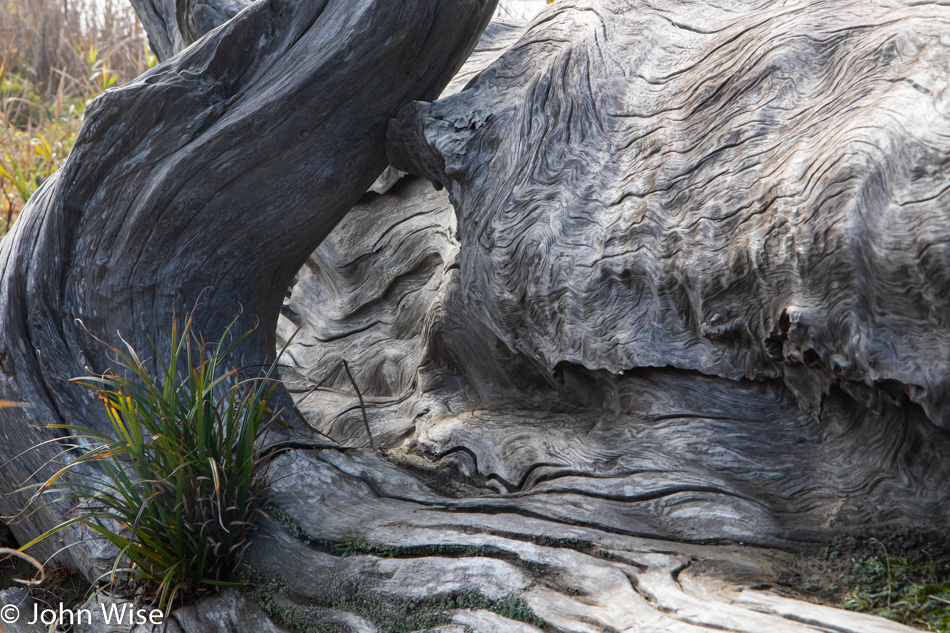
This is the biggest piece of driftwood we may have ever seen. This gray hunk of whale size tree is the hulking remnant of a Redwood. How’d this get so far up the coast from California, you might wonder? So did we.
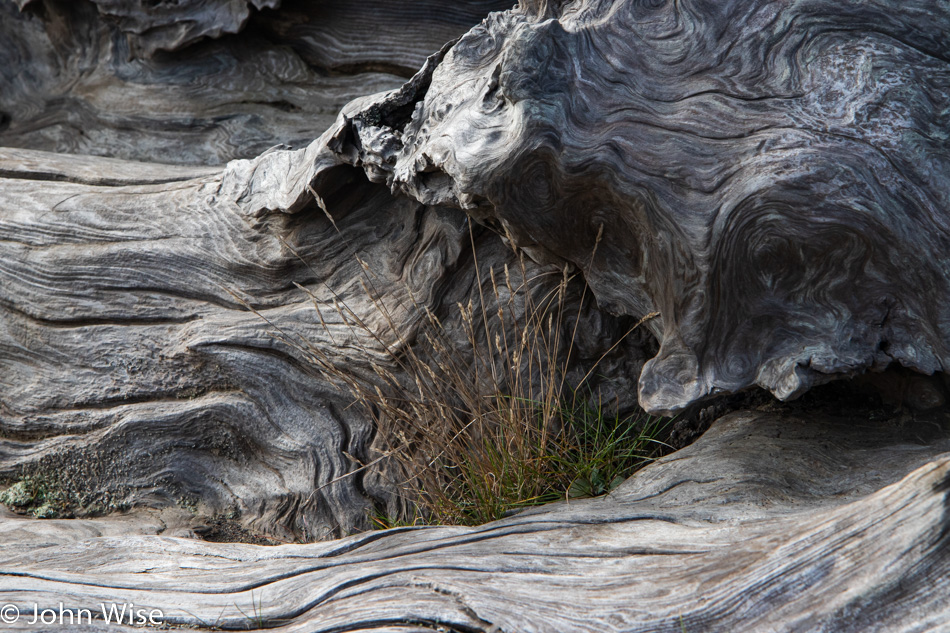
It turns out there used to be Redwoods in Oregon, and supposedly, there’s still a very small grove tucked away, but due to people’s efforts to harvest every single tree of size, ensuring there are no old-growth forests remaining on earth, Oregon is no longer known as a place that is home to these majestic trees. A local told us this tree is rumored to have been sitting right here for about 100 years now. What a sad and tragic reminder of how quickly we are ready to despoil our lands and oceans in order to move money around.
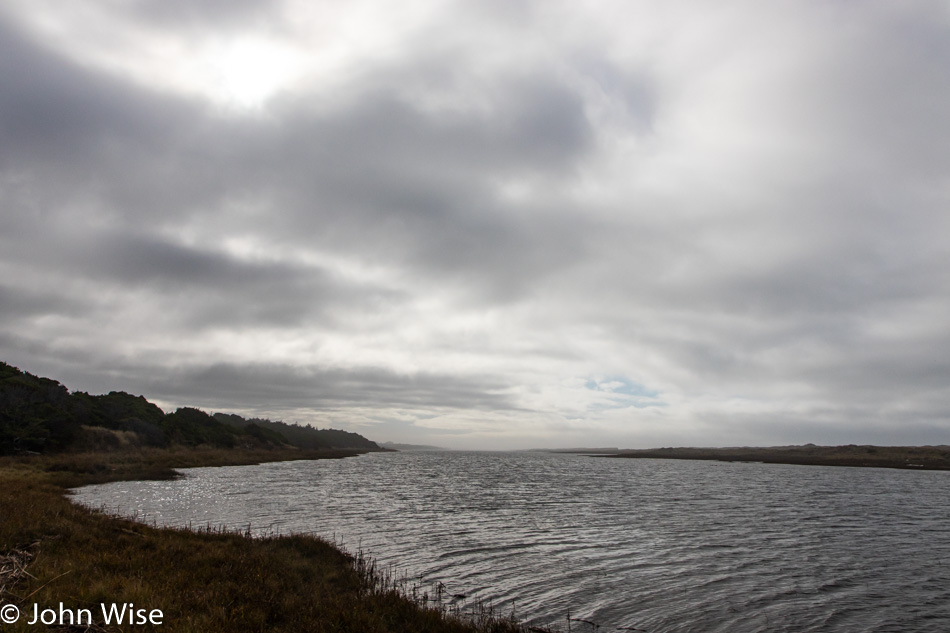
This may look like where we just were, but it’s a mile down the road. It’s still the New River, but it’s in a section of the park that once was called the New River Nature Center but appears to be the New River A.C.E.C. now, which stands for Area of Critical Environmental Concern.
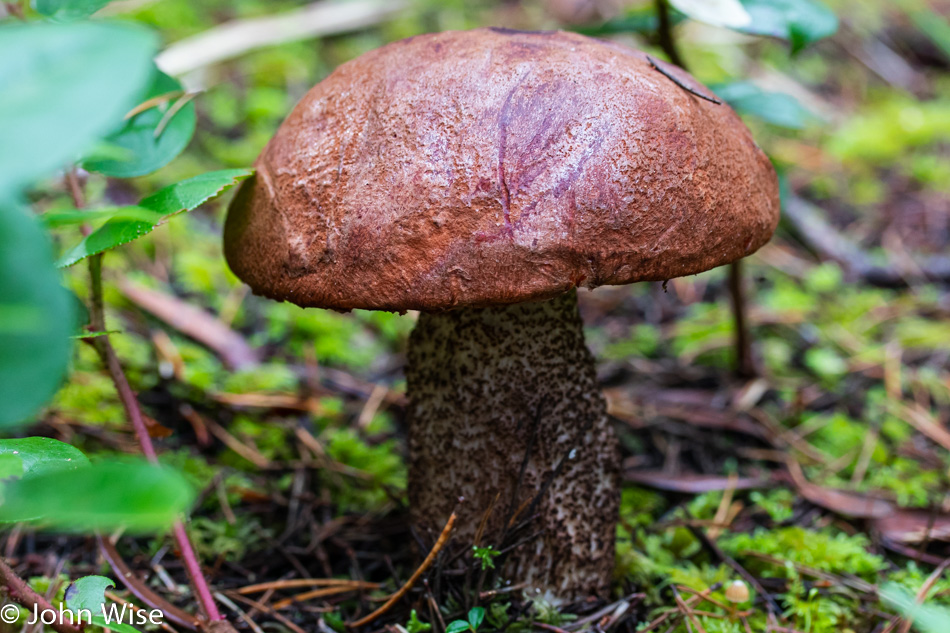
This is one of the few mushrooms that was still standing upright. While there are signs everywhere asking visitors not to harvest mushrooms, they are of little good as that is exactly what is happening here every day. What isn’t stolen by people looking for a cheap meal or sold to others is knocked over to spore more growth so the next harvest is better than the previous. While we were here, we saw a group of three people from California parked next to the road, one of the passengers getting out with a backpack disappearing off-trail into a thicket to poach mushrooms.
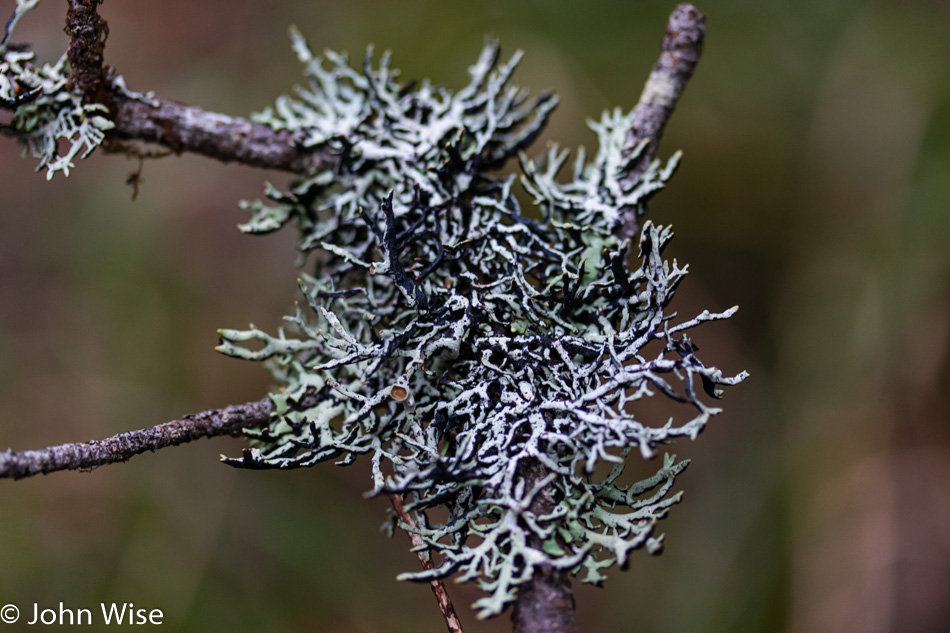
Fortunately, moss and lichen are not very palatable. While some are edible and are eaten by people in the Arctic, they are left alone by humans here along the coast.
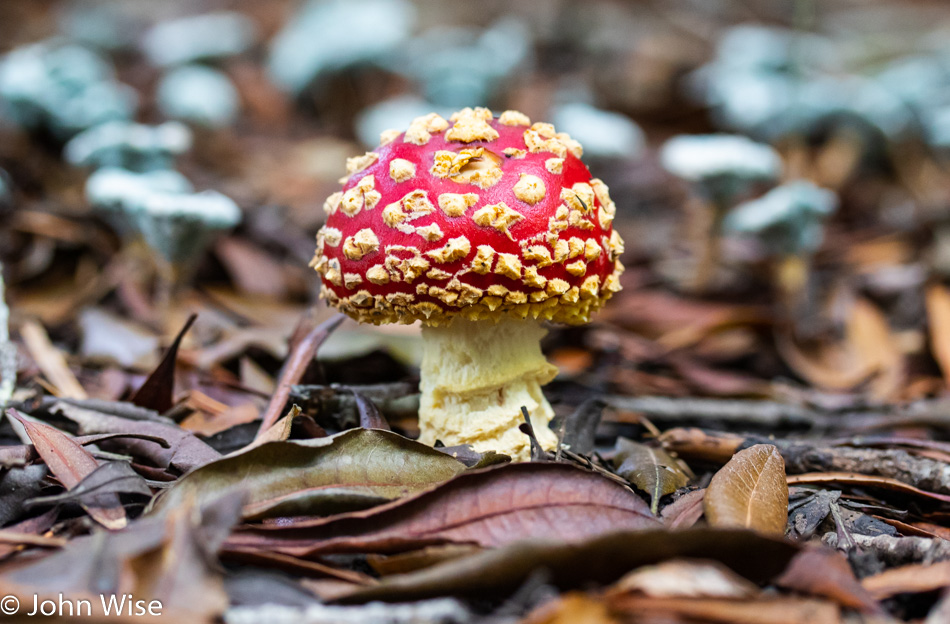
If only the mushroom hunters would stock up on these and devour a toxic dose that would remove them from the gene pool. Leave the wild mushrooms for visitors to wildlands, you ugly thieves of nature, and give greater opportunity to tourists to find more reasons to return, thus leaving their dollars in your local community. The same goes for the clear-cut trees, but I’ve written about that before.
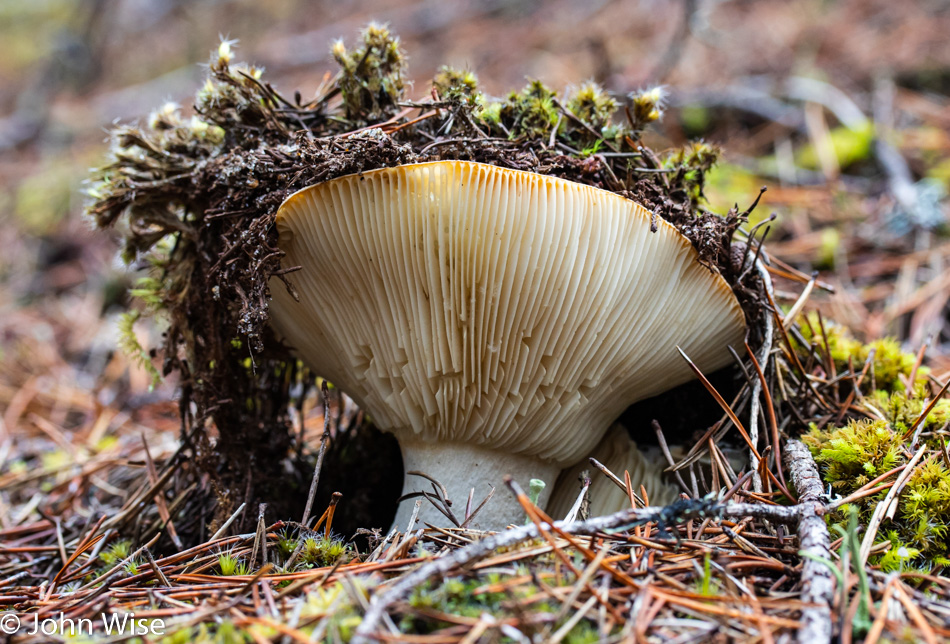
To someone walking along the path, this is a beautiful sight. It’s a rare sight that must be sought after, as the majority of trailside mushrooms have been kicked over and broken into 20 pieces.
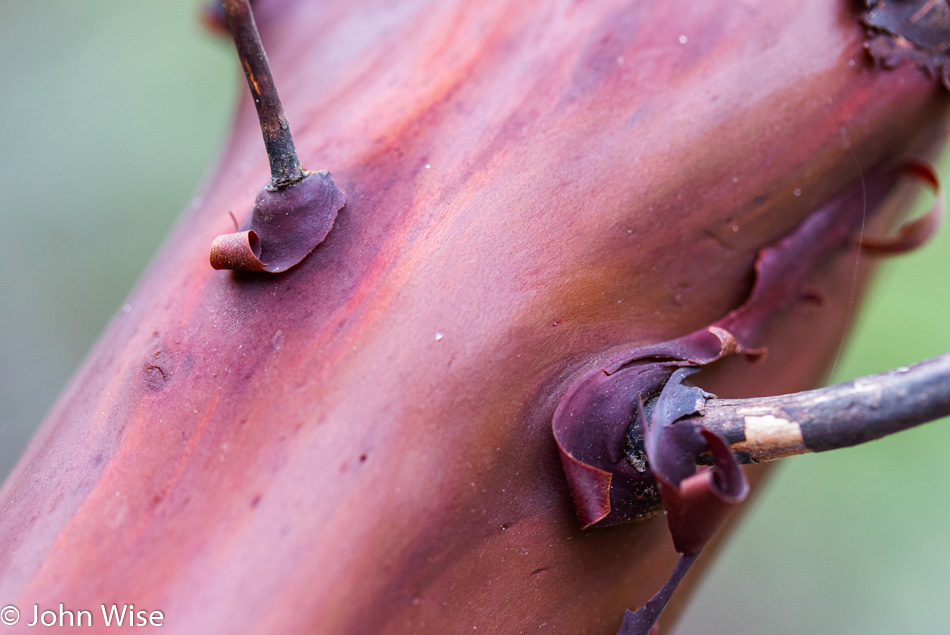
Manzanita trees feel as amazing as they look. How we could walk by them and not stroke their luxuriously smooth surfaces is beyond my imagination because once you touch manzanita, the manzanita has stroked your senses.
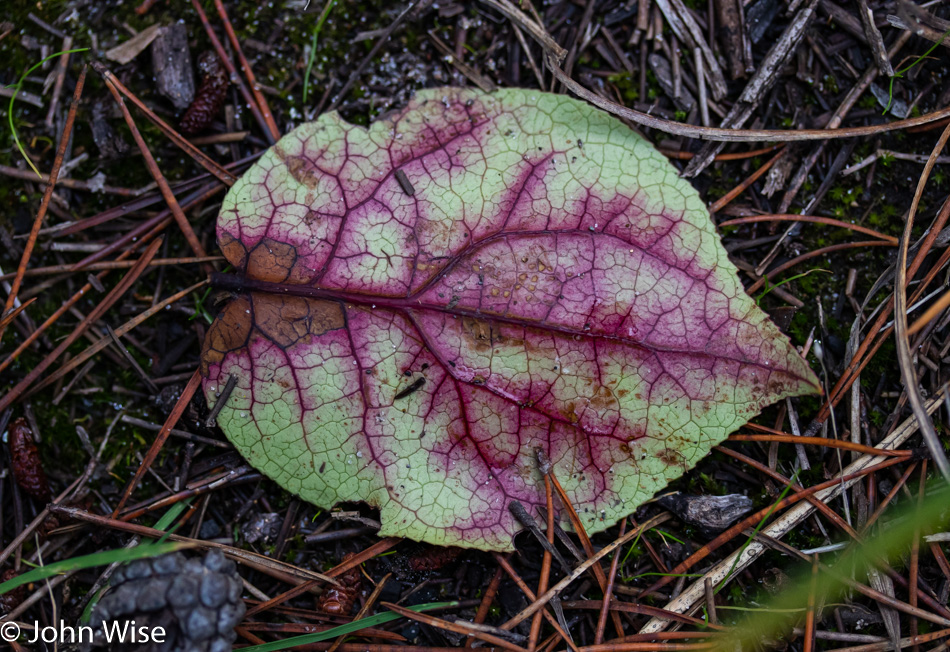
Can you tell that I decided to bring the macro lens with me? Hmmm, did I already mention this in the previous entry? Oh well, so now you know for certain it is with me, and you should expect a few images that look at things in greater detail than previous blog entries about Oregon. Far too often, I’m focused on the landscape with a look to the ocean as we are entirely enchanted with those views, and having more of them for our memories is quite satisfying, but we also are in love with the many details we see in between along the way.
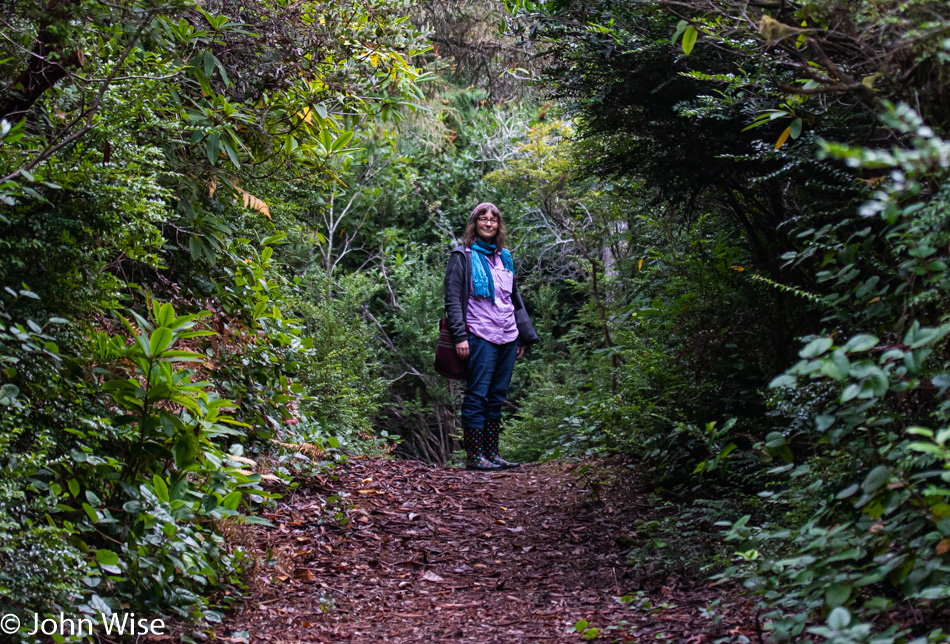
There are maybe a dozen large-sized cities on the 363-mile-long Oregon coast. The largest is Coos Bay, with about 16,000 people, so by large city standards, these are small towns. While the more typical nationwide chains have some presence out here, such as Starbucks, McDonald’s, and Walmart, we are never very far from nature. Once out on a trail or a quiet stretch of beach, it feels as though we are even further removed from the rush of city life, not that there’s a lot of that here anyway.
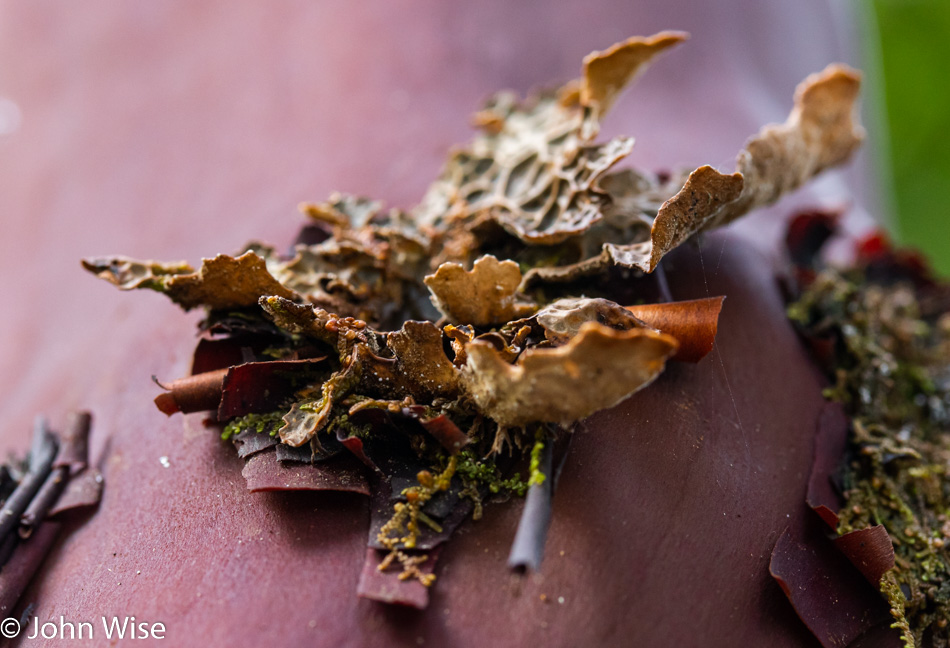
Finding the images that will feature not only the visual impact made by the many vistas but also those things that are integral parts of a complex landscape that is so much more than trees and ocean is a large part of my exercise. Just what needs to be seen that will fill the gaps of intricacies that are easily overlooked?
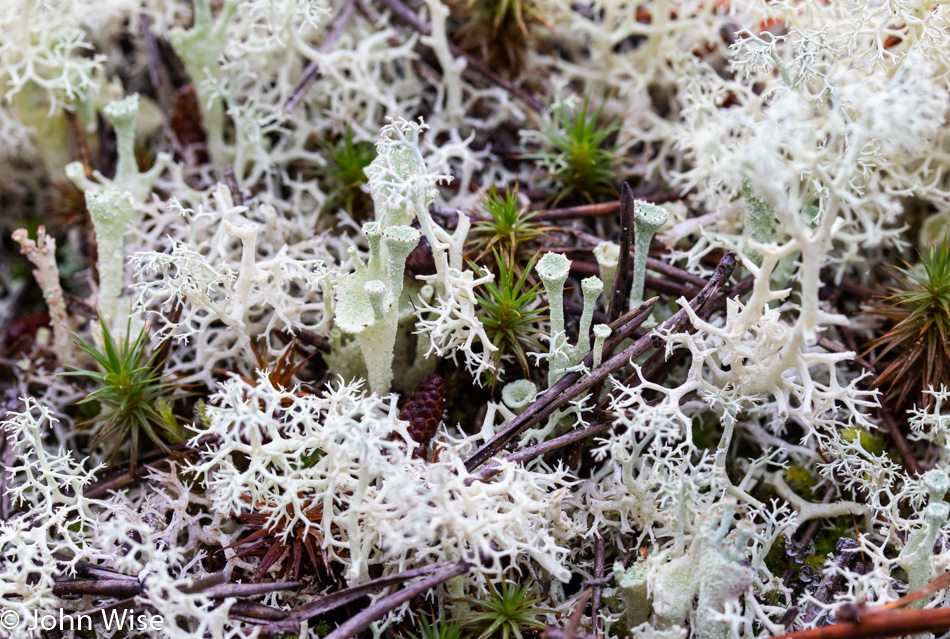
Branches reaching out leafless and white serve what purpose here in the forest? Do they have a method of using nutrients that offer a symbiotic relationship to some part of the ecosystem that is invisible to the casual observer? What are the light green golf tee looking like things? I think they are a fungus, but don’t really know.
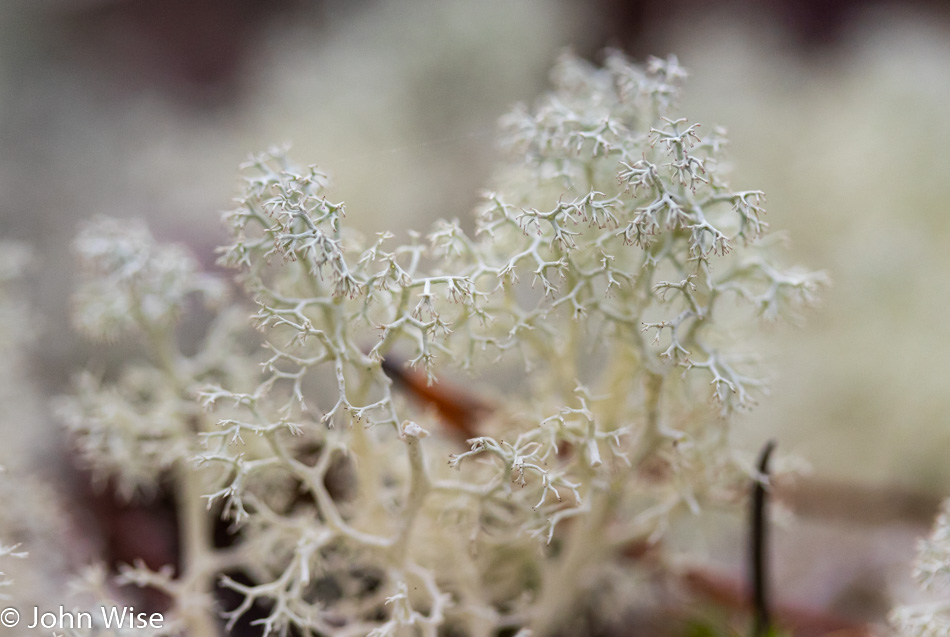
Dendrites come to mind when looking at these branching arms.
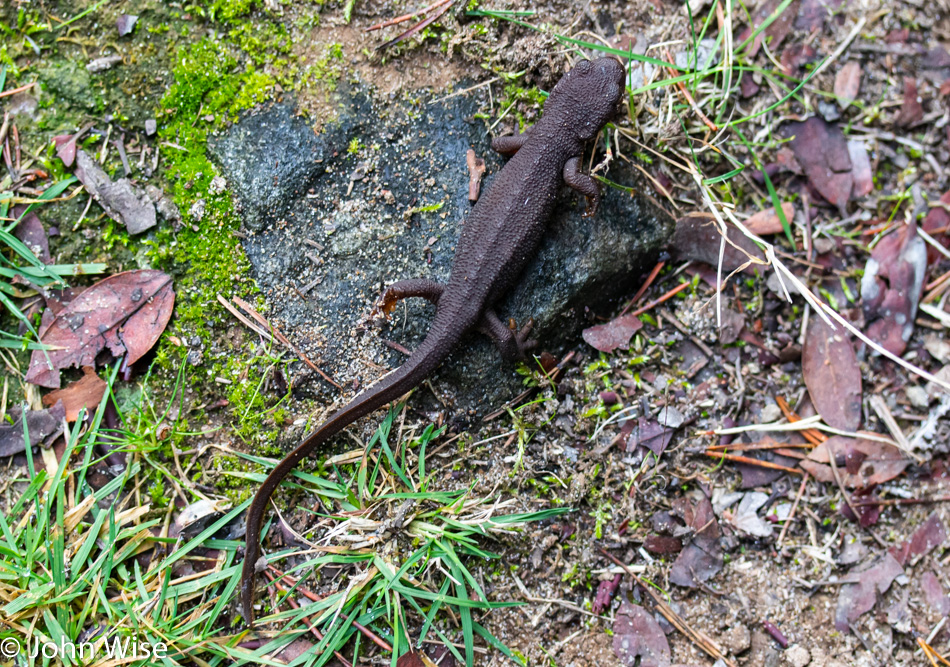
Newts on trails seem like a bad mix but are welcome hiking buddies that make us smile. Astute readers will know that it’s likely everything we see puts smiles on our faces. If I think about that for more than the second it takes to write such optimistic thoughts, I’d have to take pause and find honesty that litter and dog shit definitely do not put smiles on our faces; scowls come to mind.
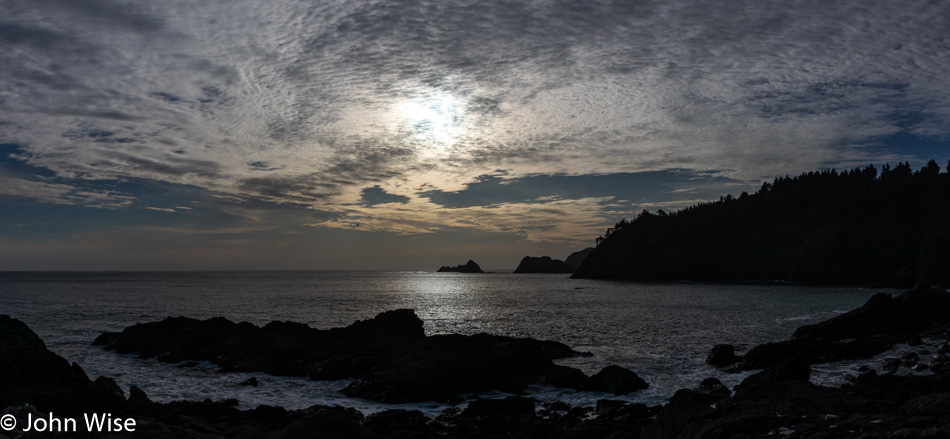
The dock at Port Orford would be the one southerly point on the coast we try to get to if we are within 50 miles of it. In bad weather, this spot is a dynamic churn of chaos that has astonished us with its fury. During calm seas, the idea of heading out of the small bay for a day of fishing is an attractive fantasy that maybe one day we could be heading out with a local skipper. Behind me is Griffs on the Dock, which serves up some decent seafood, and on my side are some water tanks where a local entrepreneur has taken to growing red dulse, which is an edible alga.
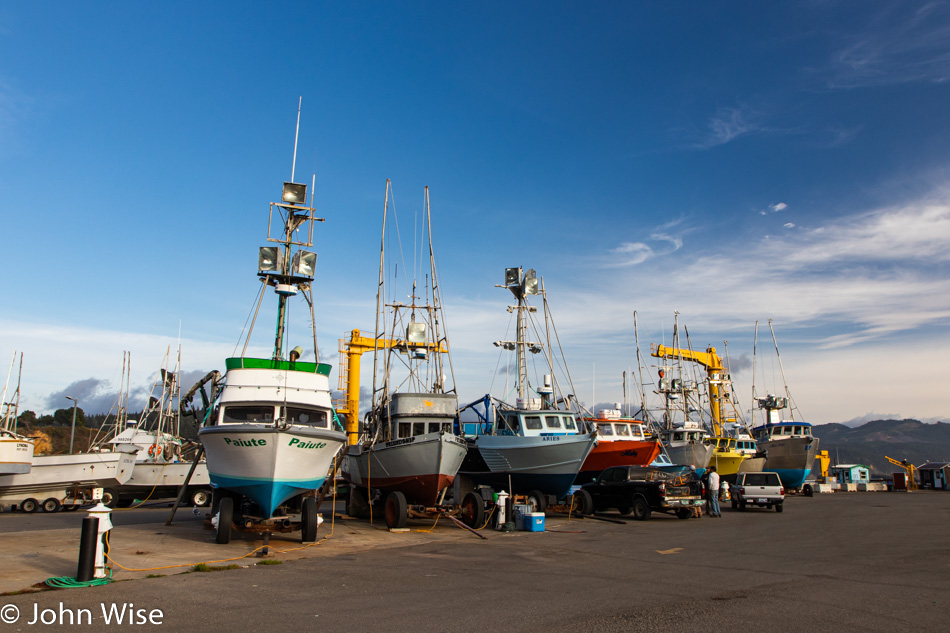
Most of these fishing boats have been here for years and the majority of them we recognize from year to year. One of the guys who captains the red one there in the middle of them all told us how the boat to his right is owned by his brother. That turquoise boat was rescued from salvage for a steal after it had flipped and bobbed in the surf, tearing it mostly apart a bit further up the coast. We were talking to him as we noticed that for the past couple of years, the crab pots that are usually on the dock haven’t been out. He informed us that the season has been getting a later and later start due to the small size of crabs that need to reach a certain size to harvest.
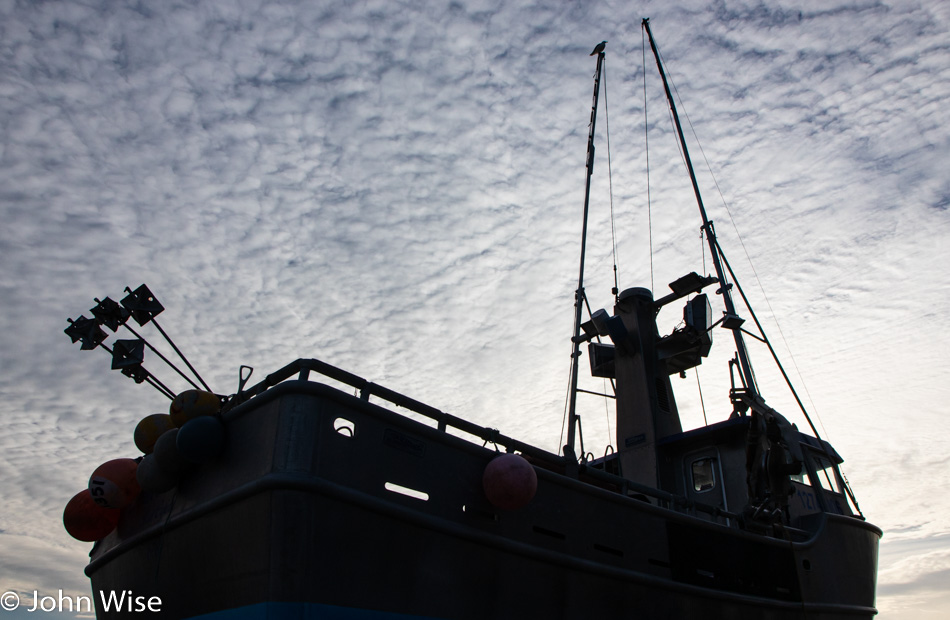
It’s kind of funny that for the many times we’ve been down here on this dock, we’ve never seen one of these boats in the water. Maybe we could time a future visit to coincide with them pulling a boat or two out of the water.
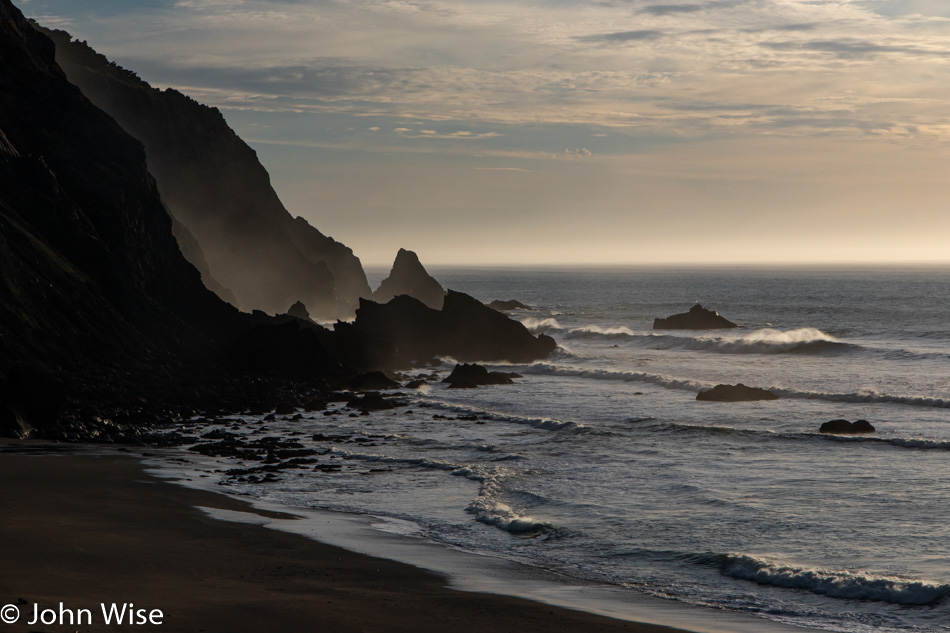
Humbug Mountain is about 50 miles north of California, and it is the furthest point south we’ll travel on this vacation. We’ve been meaning to climb the trail up this bulwark even though we’ve read it doesn’t offer any spectacular views, but to date haven’t been able to fit it in. On another occasion, we had the time but didn’t have the gear for the amount of rain that was coming down.
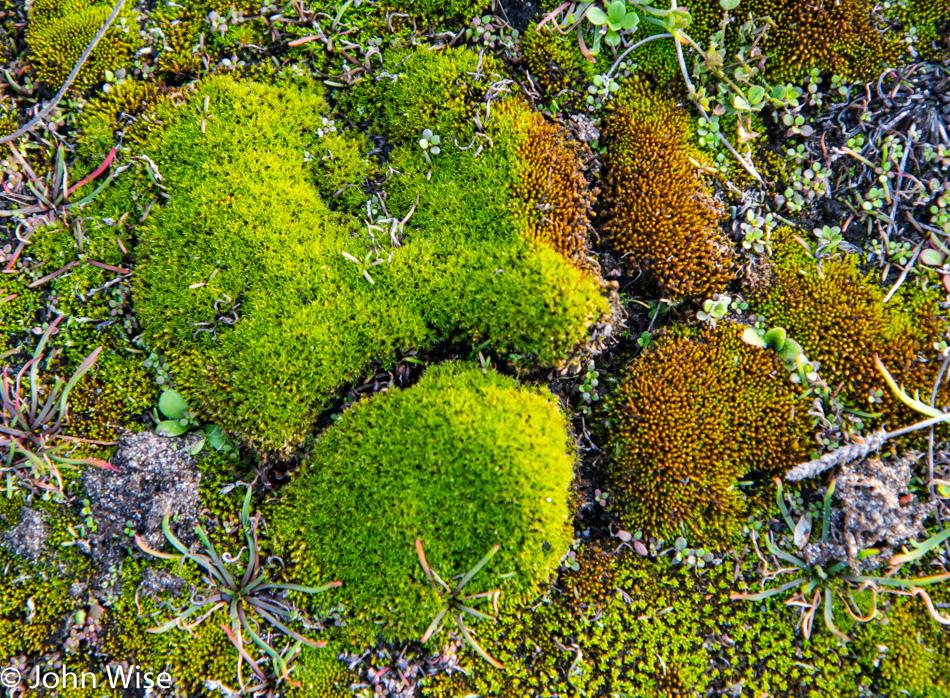
When we pulled over on the north end of the mountain next to the road, we jumped over a barrier that keeps cars from careening off the cliff, though there are plenty of other locations to do just that if this were your inclination. Expecting dirt and trash, we were surprised by the moss and something else that I’ll show you after the next photo of a sunset.
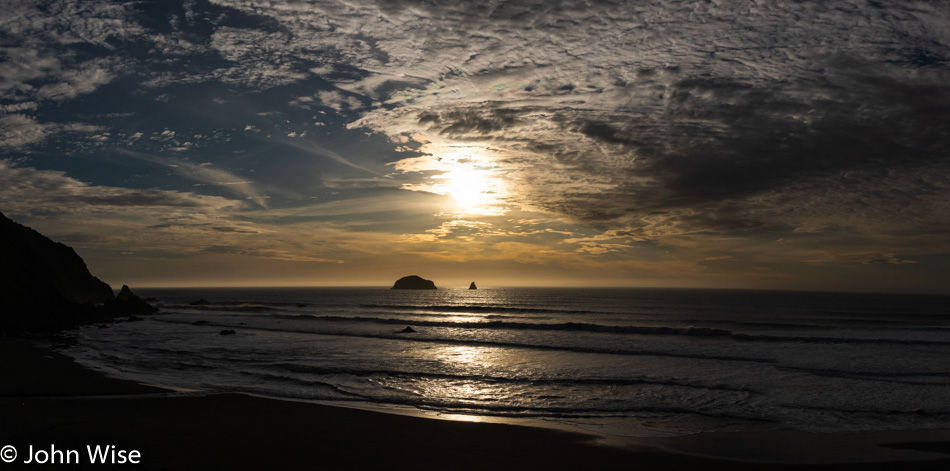
I could have skipped this gratuitous inclusion of yet another sunset photo as there’s another that shares some similarity to this one, but the warmth, clouds, golden glow, and fog in the distance are so enchanting I just had to share it.
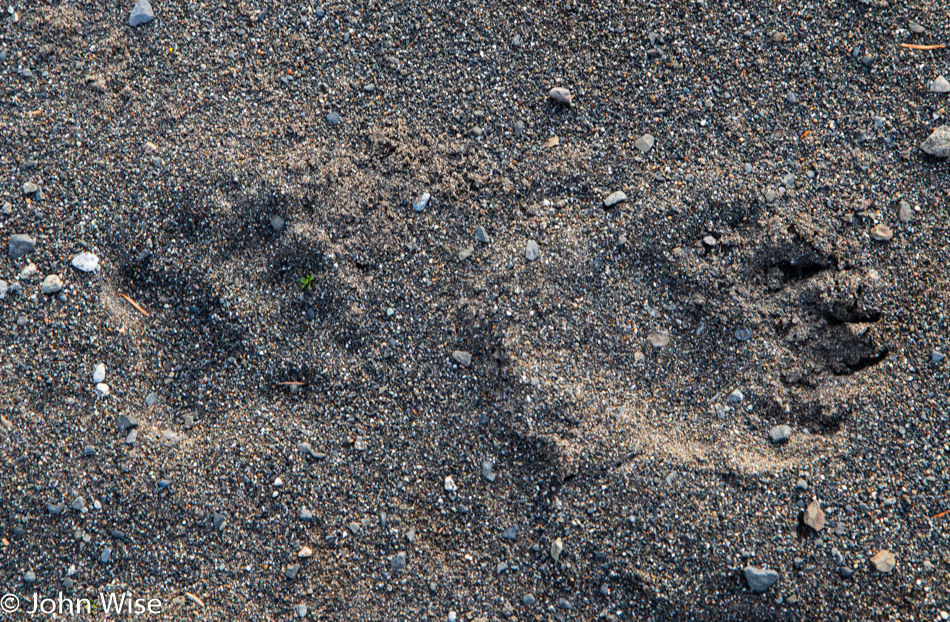
Bear tracks. We had no idea that we’d ever really see bear tracks this close to the ocean and on a cliffside next to the road, that means it had to cross that highway to get over here.
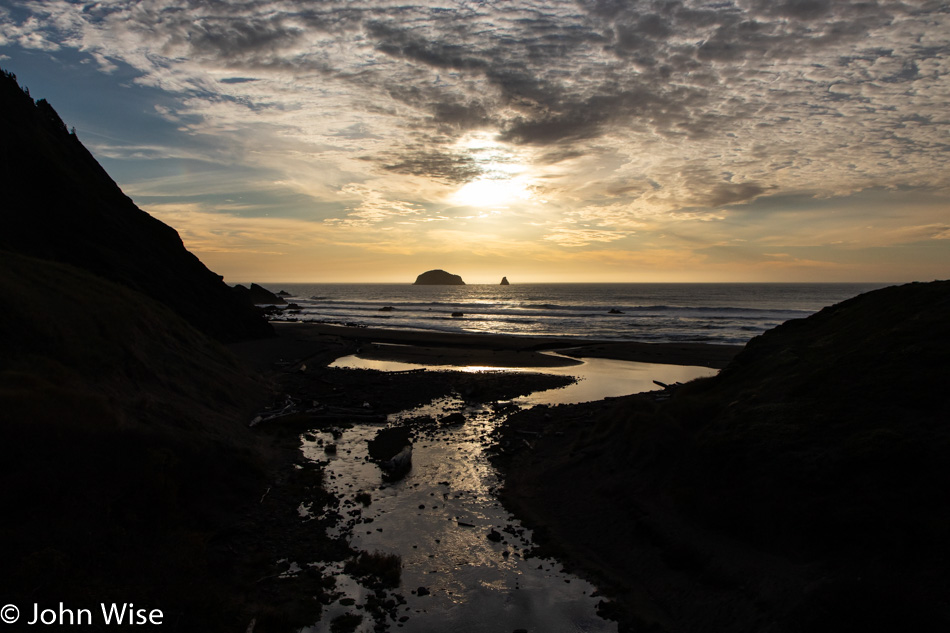
So the story behind the inclusion of this sunset photo that shares some resemblance with the one above is that this one has Brush Creek illuminated by the setting sun, and Caroline insisted I take this photo for her.
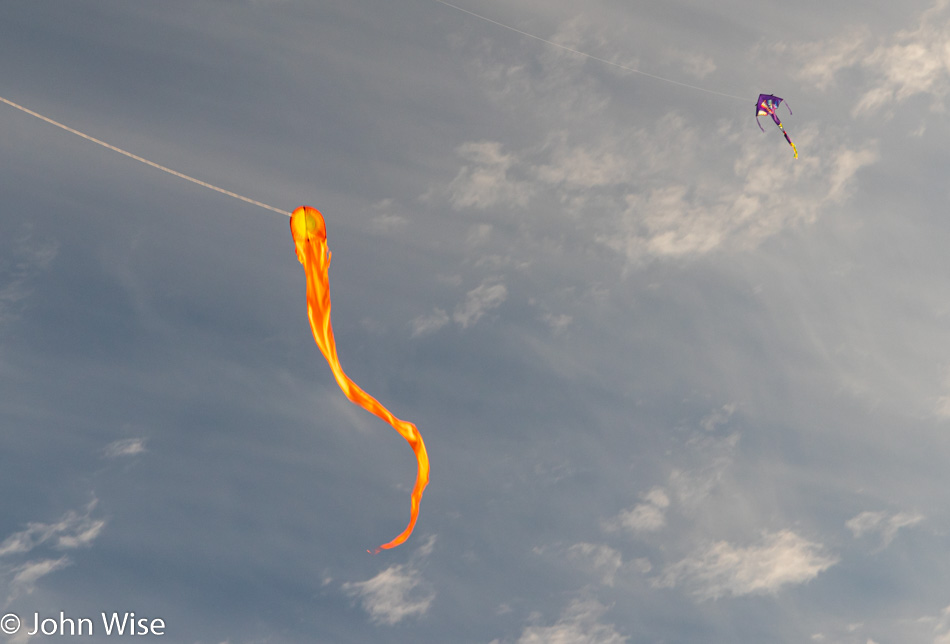
Here we are back in Port Orford because one can never visit this town too often. The particular stop is at Battle Rock Wayside and is the same place Caroline lost her phone on a previous visit.
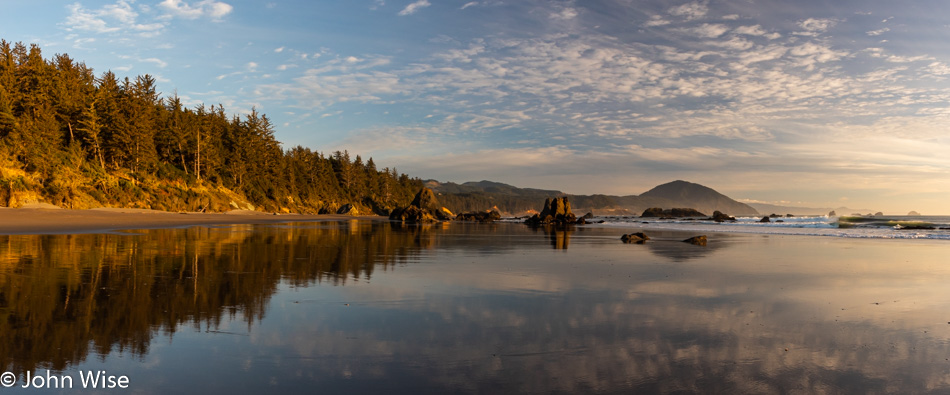
This is why one can never visit Battle Rock Wayside too often. The timing of being here at low tide for sunset was not planned for. Other than where we are staying, there was no fixed itinerary for what we might be doing while up here in Oregon. The hope is to find new things to do should we realize that we’ve visited a particular location one too many times, but like all previous visits, we drop in on our familiar haunts with all the enthusiasm as though it’s the very first time we’ve ever seen the place.
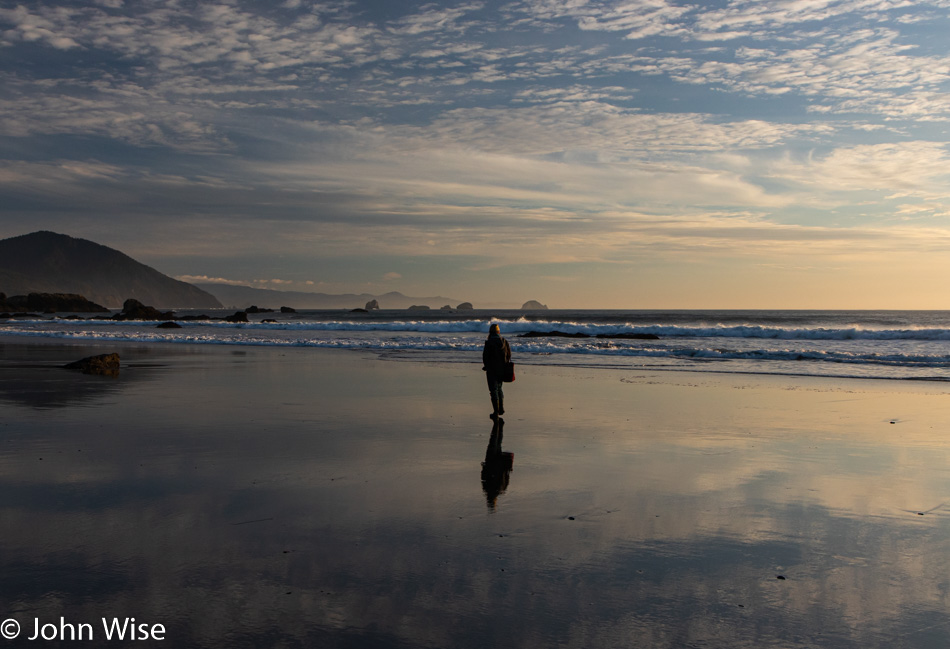
I’d swear Caroline is in another world when she’s at the ocean. I’d love to know her perspective and how she sees this seascape in front of her. While I look for photos, sounds, words, and other things to record in my mind to convey here at some future date should I find the time, Caroline is over somewhere else searching and observing her happy place in a way I can never fully appreciate. She’s never gone long, I should point out, as we reconnect every few minutes and then walk together for a while, sharing a kiss, a hug, a snuggle, an exchange of words that profess our love for each other.
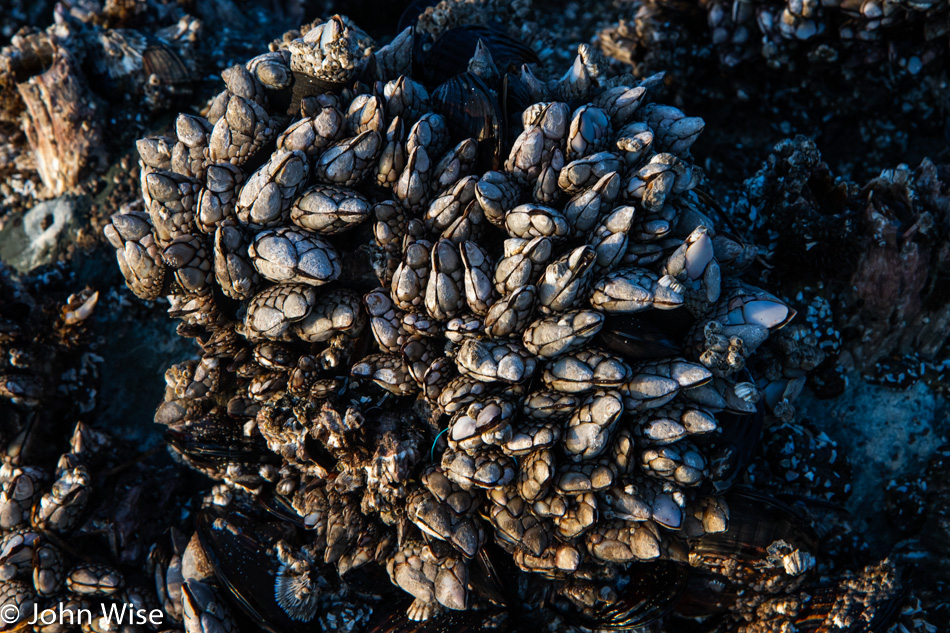
Are these the same gooseneck barnacles we’ve seen here before? The likelihood is pretty good that they are, as some barnacles can live as long as ten years.
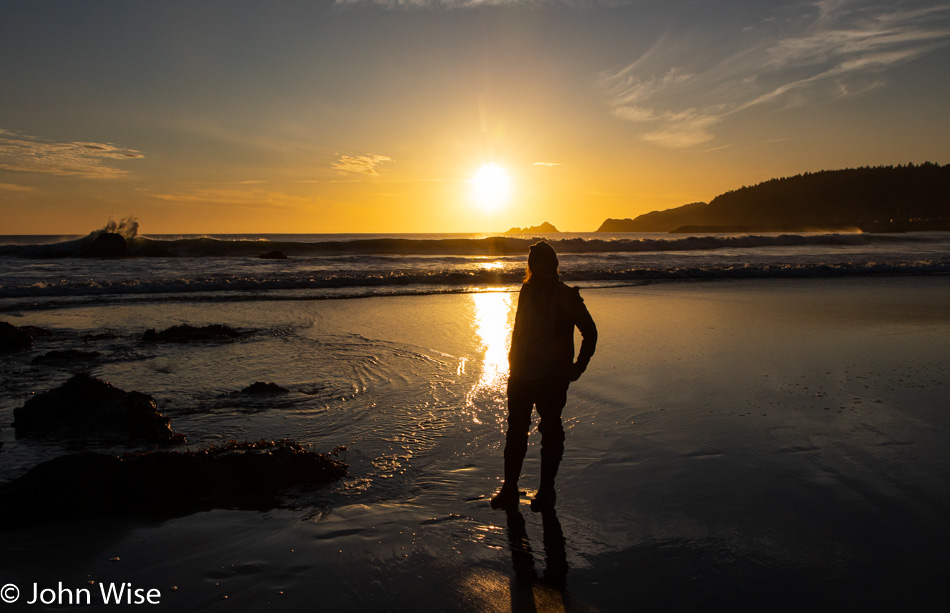
At home in Phoenix, Caroline works hard and often long hours but one of the luxuries of having committed so much to learn to do what she does is that she usually has great benefits. While health care takes greater and greater importance in our lives as we age towards our 60’s it is time off that is the best reward. Knowing how to use that rare commodity for things other than the mundane becomes our greatest treasure, and getting out for traveling is the best use of that time we know. If Caroline could correct me here on the blog, she would likely add that having time at home for weaving, spinning, knitting, and other fiber-related arts is also of importance to her.
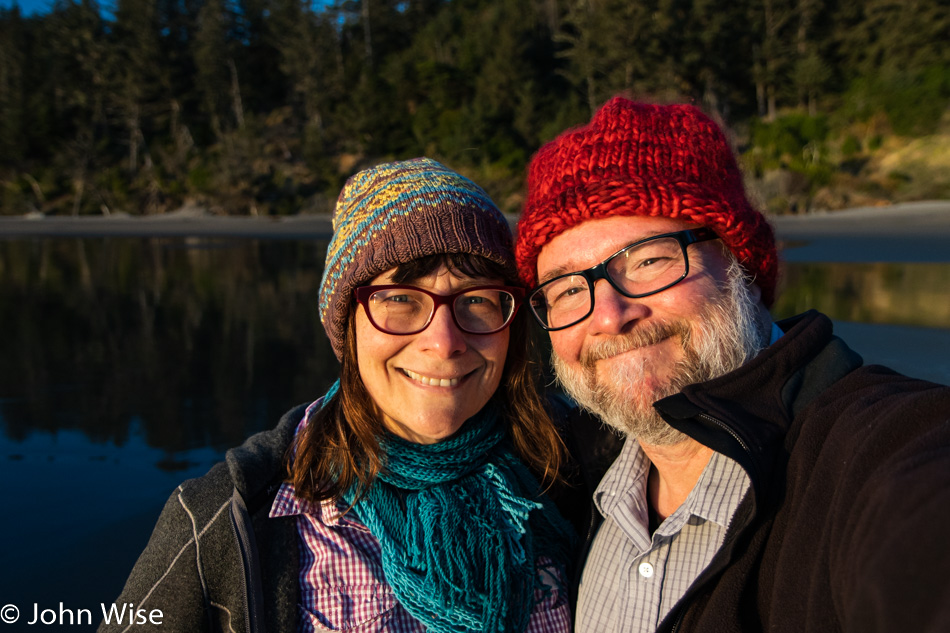
One of our encounters where the smiles at the situation become too much to bear for one person, and to balance the load we reach out to each other and blurt something or other out about how lucky we are or how much we love each other. There’s a lot of telling each other how much love we feel and how happy we are to be out here once again.
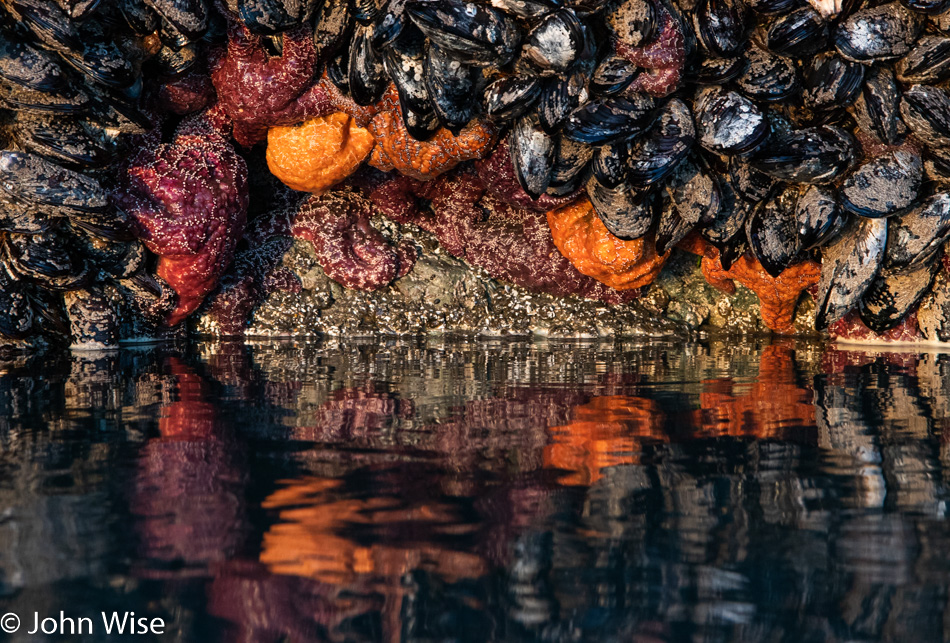
Starfish were in short supply on our last couple of visits, but they have bounced back this year. The tide also appears to be one of the lowest we’ve ever witnessed here. These windows into coastal life are extraordinary but could be so much more interesting if Oregon were to recognize the value of knowledge sharing out here and give us digital docents so we could listen to audio tours of information regarding each section of the coast we are visiting. Explain to us how clear-cutting helps the environment or business or whatever. Give us info about the wildlife refuges and estuaries. Bring in marine biologists to tell the stories of the ebb and flow of habitats and species.
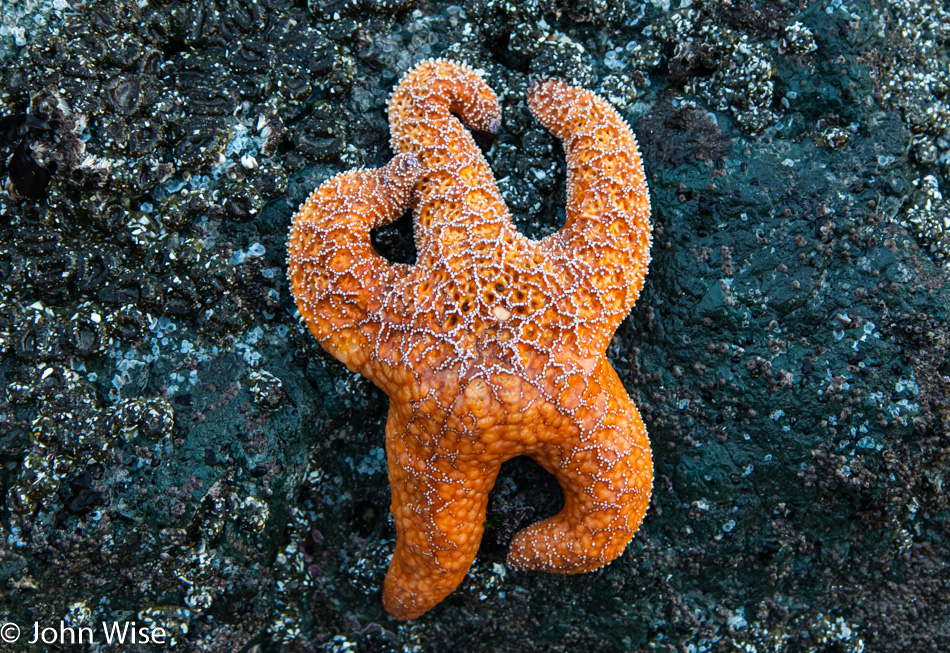
If this isn’t a sexy pose, I don’t know what is. It looks kinda hot, huh?
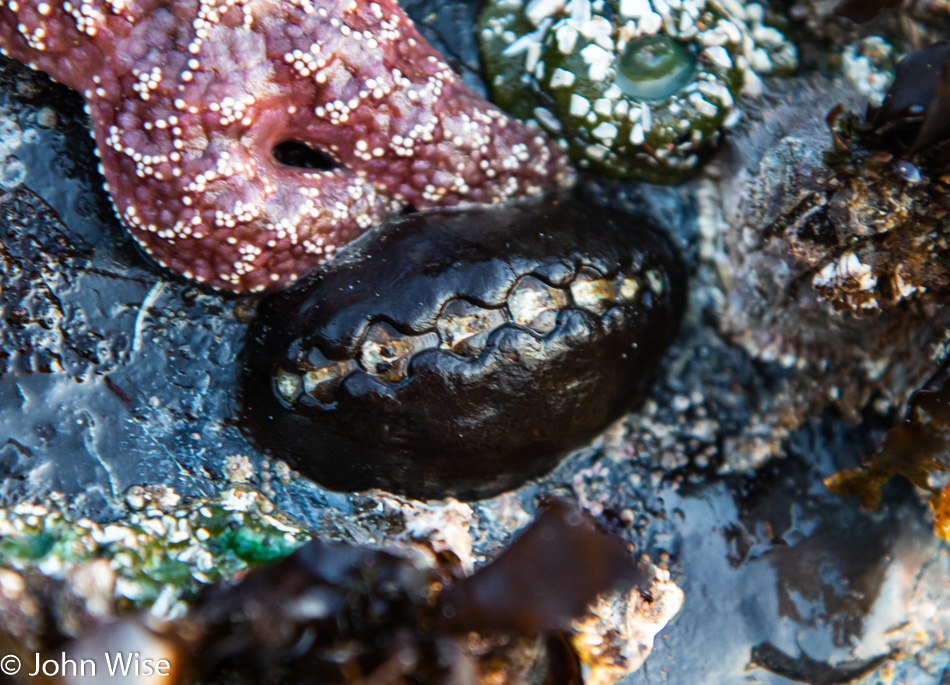
Chitons are the kevlar of the sea. At least, I’m fairly sure they are bulletproof. This type is known as Katharina Tunicata or, more commonly, the black Katy chiton. I’ve read they were good eating by indigenous California tribes but how they are harvested is beyond me.
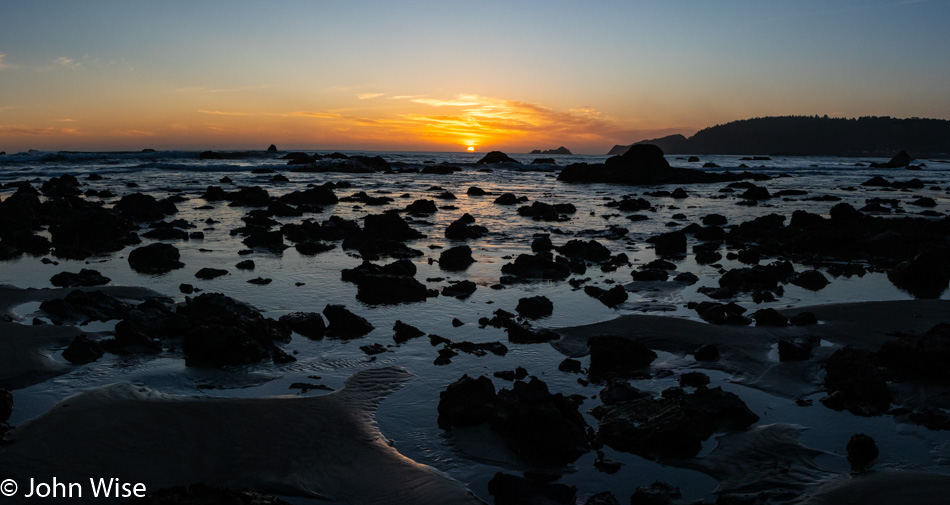
As I said, we’ve never seen the water this low. By now, we are only enjoying the setting sun as checking out the wildlife has grown more difficult in the fading light.
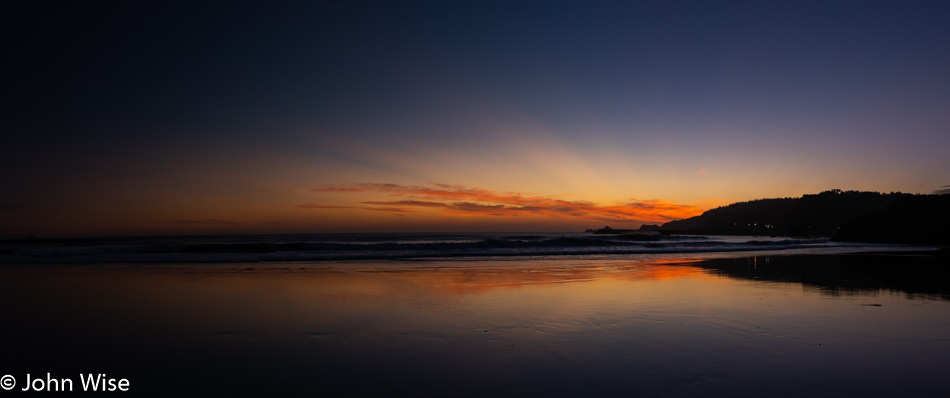
We took a good long time to leave the Battle Rock Wayside here at Port Orford, even though we knew we had a long drive ahead of us. Not too long but long enough, plus we would need to stop for dinner.
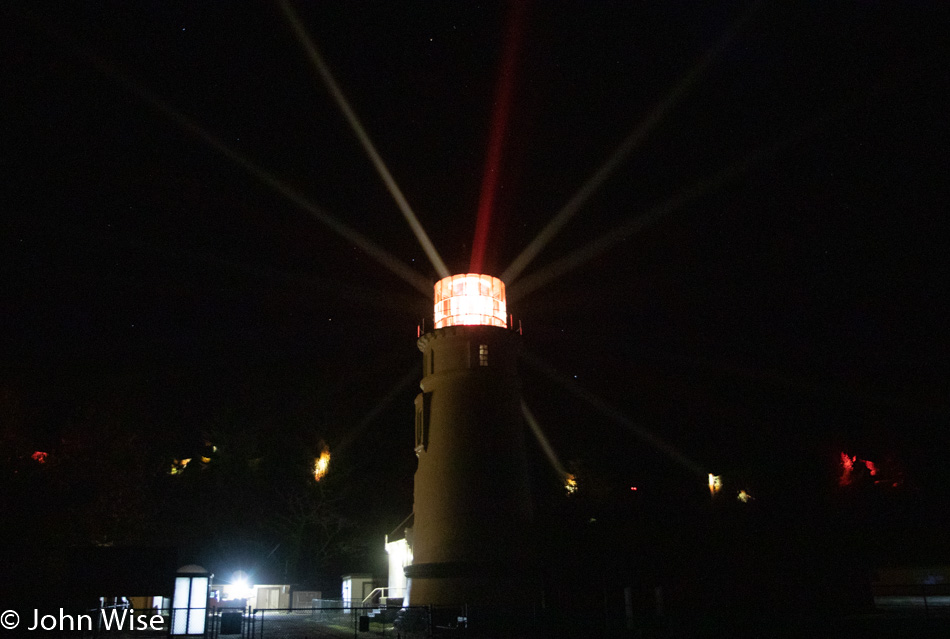
Dinner was back in Coos Bay and was another forgettable meal at a place not worth mentioning, but we’re not here for culinary delights. Our lodging this evening is close to the Umpqua Lighthouse in the state park that bears its name. This is our first night in a yurt on this trip; two nights will be spent right here while we’ll be in various yurts for a total of five nights this week. While it’s difficult to see in this photo when it’s presented so small, there are many a star in the sky this evening. What else can’t be shared is the strange silence of the light penetrating the night sky and illuminating the fog and flashing on the trees as the light turns. Somehow, it feels like the two white and one red light should have some kind of tone or pulsing sound as it slices through the darkness.

